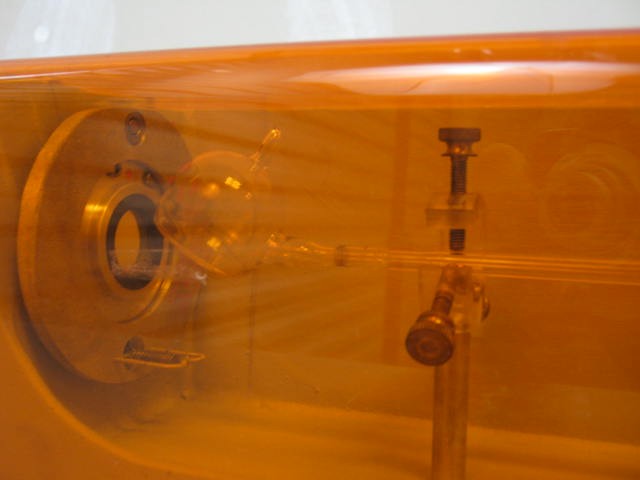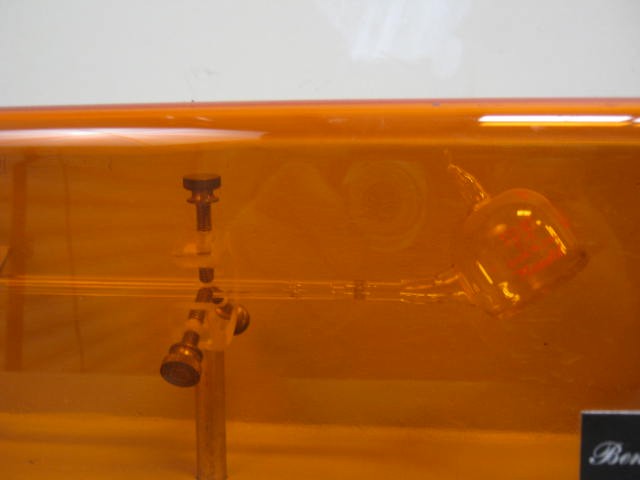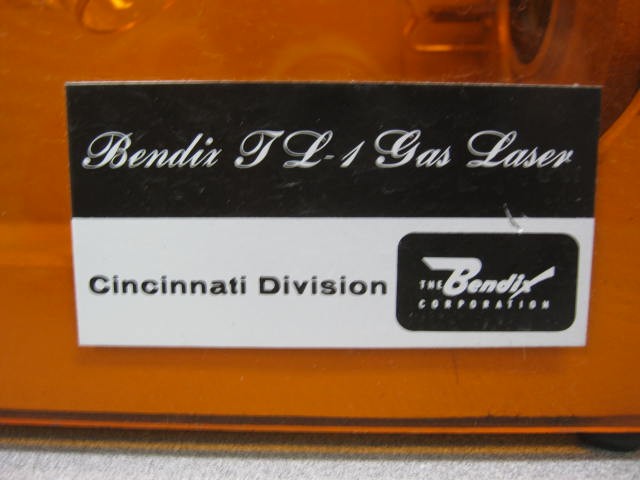When Your Laser Doesn’t Fit the Mould
The vast majority of He-Ne tubes and laser heads you will likely come across will be basically similar to those described in the section: Structure of Internal Mirror He-Ne Lasers. However, when rummaging through old storerooms or offerings at hamfests or high-tech flea markets, you may come across some that are, to put it bluntly, somewhat strange or weird. I would expect that in most cases, these will be either really old, developed for a specific application, or higher performance lab quality models which are just not familiar to someone used to surplus specials. Consider these to be real finds if only for the novelty value! Refurbishing of the lab-grade lasers may be worth the effort and/or expense resulting in a truly exceptional (and possibly valuable) instrument. And, simply from an investment point of view, it is amazing what some old (and even totally useless dead) but strange lasers have fetched on places like Ebay Auction recently.
- Really old He-Ne tubes are very likely to be non-functional as inadequate seals were probably used (Epoxied Brewster windows or mirrors) and would need to be re-gassed, at the very least.
- Special purpose He-Ne lasers could come in a variety of shapes and sizes. I wouldn’t even know what to tell you to look for in this area!
- High performance lab quality lasers will have external mirrors with fine adjustments, more sophisticated internal or external optics, power supplies with tweaks and monitoring meters or test points.
Here are some descriptions of what I and others have come across:
Segmented He-Ne Tubes
I have several medium power He-Ne tubes that do not have a single long bore (capillary) but rather it is split into about a half dozen sections with a 1 or 2 mm gap between them. Each of the short capillaries is fused into a glass separator without any holes. Two of these tubes look like the more common internal mirror He-Ne tubes except for the multiple segments as shown below:
____________________________________________
/ | | | _______ \
Anode |\ | | | \ | Cathode
.-.---' \.-----'-----..-----'-----..-----'------. '-'---.-.
<---| |:::: :===========::===========::============: :::::| |===>
'-'---. /'-----.-----''-----.-----''-----.------' .-.---'-'
|/ | | | _______/ |
\_______|____________|____________|__________/
Or, for a more aesthetic rendition, see:

The third has Brewster angle windows at both ends with an external (fixed) HR mirror and an external screw-adjustable OC mirror. The cathode is also in a side-tube rather than the more typical coaxial can type but is otherwise similar.
Only one of the 3 He-Ne tubes of this type that I have works at all and it has a messed up gas fill probably due to age despite its being hard sealed. Its output is perhaps 1 or 2 mW (where it should be around 20 mW). However, to the extent that it works, there doesn’t appear to be anything particularly interesting or different about its behaviour. Of the other two tubes, one has a broken off mirror (don’t ask) but before the mishap, did generate some decent power (perhaps 5 to 10 mW but still nowhere near its 20 mW rating) but erratically. I suspect this was due to a contaminated gas fill resulting in low gain rather than the segmented design since a couple of other similar length tubes of conventional construction behaved in a similar manner. The funky tube with the external mirrors was not hard-sealed at the Brewster windows and leaked over time.
The only obvious effect this sort of structure should have on operation would be to provide gas reservoirs at multiple locations rather than only at the cathode-end of the bore as is the case with most ‘normal’ He-Ne tube designs. I do not know whether this matters at all for a low current HeNe discharge. Therefore, the reason for the unusual design remains a total mystery. It may have been to stabilize the discharge, to suppress unwanted spectral lines, easier to maintain in alignment than a single long capillary, or something else entirely. Then again, perhaps, the person who made the tubes just had a spurt of excessive creativity. 🙂
I have also acquired a complete laser head with a similar tube, rated 25mW max with a sticker that says it did 22 mW at one time. It is unremarkable in most respects but does have a large number of IR suppression magnets arranged on 3 sides over most of the length of the tube. Currently, it does not lase because the gas is slightly contaminated but it is also misaligned. The discharge colour is along the lines of “Minor – Low Output” below:
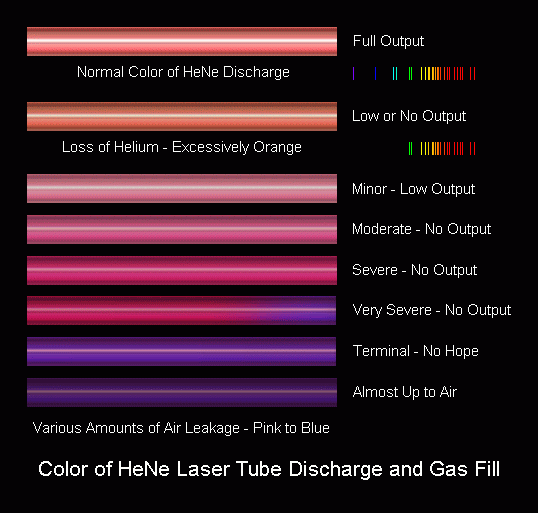
so there may be some hope.
Strange High Power He-Ne Laser
This is a on-going project on finding information and restoring a strange He-Ne laser acquired by: Chris Chagaris (pyro@grolen.com). Research to determine the specifications and requirements involved postings to sci.optics, email correspondence, and a bit of luck – seeing a photograph of the mysterious laser in a book on holography.
Here is the original description (slightly reformatted):
(From: Chris Chagaris (pyro@grolen.com).)
I have recently acquired what I have been told is a 35 mW Helium Neon laser head. However, it is unlike anything I have ever seen before. (See the diagram, below.)
Capillary tube/external starting electrodes
Starting pulse o-------+----------------------+
_|_ _|_
|| //==================================================\\ ||
|| //====. .==================. .=================. .====\\ ||
||| | | |||
Mirror '|' 25K | | 25K '|' Mirror
Anode 1 +---/\/\---o +HV | | +HV o---/\/\---+ Anode 2
.---------------' '--------------.
---|-+ +-|---
| ) Main Spare ( |
---|-+ +-|---
'--------------------------------'
Gas reservoir with heated cathodes and getters
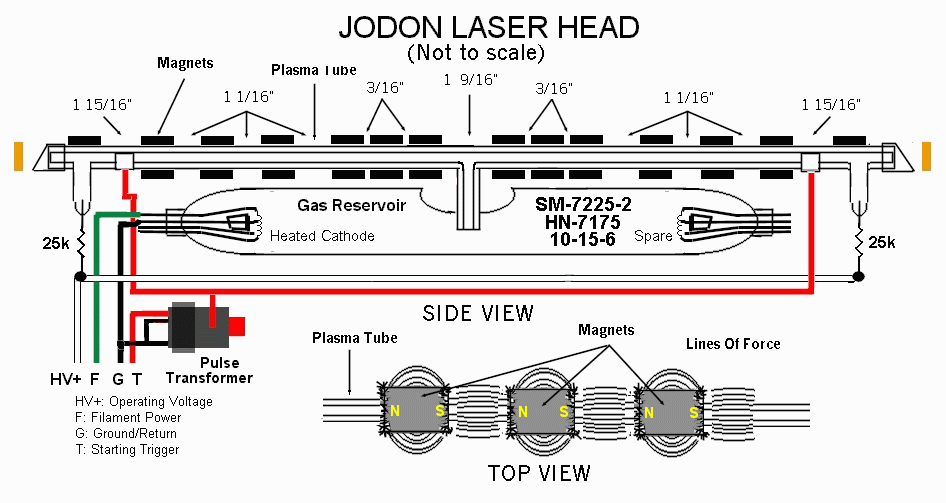
Above shows the construction in more detail.
- It has no external markings except for “CAUTION LASER LIGHT” on one end and “DANGER HIGH VOLTAGE” on the other end.
- The exterior is a grayish/green rectangular metal box 4″ x 4″ x 32″ long with a ventilated top and bottom. It has four adjustable metal feet on the bottom and a 1-3/8″ dia. x 7/8″ long silver bezel on the output end.
- The resonator tube itself consists of a 2 mm I.D. capillary tube approximately 27″ long (with about 12 wiggler magnets along the axis).
- Attached in the center is a glass reservoir that is 30 mm in diameter and about 13 inches long mounted underneath.
- This large glass tube has what are some sort of filaments at each end with four electrodes on each. Only one side is connected to the input power wires (black and green) using only two of the electrodes.
- The only other markings are on this reservoir, and from what I can make out are “SM-7225-2 HN-7175 10-15-6”.
- A white input wire (anode?) runs to ballast resistors (25K) connected to electrodes near each end of the capillary tube.
- A red input wire is connected to what looks like some sort of trigger transformer – one inch in diameter by 1-1/4 inches long with a 2-1/2″ long x 3/8″ core in the center (ferrite?).
- The other two input terminals of this transformer are connected to the black input wire which is also grounded to the case.
- The output of the trigger transformer is connected to two fuse clips externally attached 4-1/2 inches from each end of the capillary tube. There is about 300 ohms resistance between the input and output of this device.
Here is one reply Chris received by email from someone else named Marco. As you will see, this turns out to be a dead end.
(From: Marco.)
“Hi Chris,This seems to be a really old one, or from other location than west Europe, Japan, and the USA. The ‘SM’ could be an abbreviation for Siemens, they had manufactured lasers from 1966 to 1993; until last year Zeiss/Jena has taken over the production; and since 1997 Lasos has overtaken the production by a kind of management buy-out. You can send them the number, it will be possible that they know it. Contact Dr. Ledig. I will also look around if I can help you further.
He-Ne lasers with a heated filament are no longer built. To see if it still runs you can attach a 3.3 V supply to the filament and see if it glows red, not more, to much heat will destroy it. You could use transformers from tube amplifiers for the filament and an old He-Ne laser power supply for the anode.
This laser will need around 5,000 V and 10 mA I think. If you could only get a smaller power supply, you may not see any laser beam, but you can see if it will trigger.”
(From: Sam.)
Here are my ‘guesses’ about this device. (I have also had email discussions with Chris.)
I agree with much of what Marco had said.
- This IS likely quite old. Unlike modern He-Ne lasers, it uses a heated cathode instead of the common aluminium ‘can’ cold cathode. Perhaps the last number is a date code: 10-15-6. The ‘6’ could either be the first part of a date that is rubbed off (e.g., ’68) or the last digit (’66, ’76). It is almost certainly before the mid seventies as He-Ne tubes I have seen from that era were very similar to modern ones in construction.
- I expect the anode voltage (on the white wire) to be in the 2 kV to 3 kV range. Based on the diagram, the actual discharge length is about 12 to 14 inches in two sections, not the entire length of the capillary tube. The current may be higher than a modern tube because the bore is wider (2 mm). Perhaps, 10 to 15mA for each section (20 to 30mA total).
- With the wide bore, it may be multimode, not TEM00.
- A microwave oven transformer would be ideal for the main supply if it were not so dangerous. And it IS – don’t be tempted. A voltage doubled boosted tube type TV power transformer should be able to provide 1,000v AC resulting 2,800 V DC – this may be enough. At the expected current, an inverter might be tricky (at least for testing) as up to 100W may be required.
- The trigger transformer probably operates like one for a large photo flash or flash lamp pumped laser. I would guess discharging a capacitor of a few µF at several hundred volts into it will work. However, if I were building the power supply, I might just ignore the trigger transformer and use a more conventional approach – a voltage multiplier or HV inverter. One less unknown to worry about. However, each of the two anodes would need to have its own feed from the starter.
- With too small a power supply, there would likely be at least a flash of laser light at the instant that the discharge was initiated – if the tube is still functional. This would occur even if the power supply was inadequate to sustain the discharge.
- I would power the filament from a low voltage transformer using a Variac and, as noted, not push it!
Unfortunately, Chris has determined that re-gassing will be required and he is equipped to do this but there will be some delay in the results…..
(From Chris (a few months later).)
Well, tonight while looking through the “Holography Handbook” I spied what looked suspiciously like that elusive laser I have. It said it was made by Jodon Engineering Associates of Ann Arbor, MI. I immediately called them and was fortunate to have the engineer (Bruce) who has built their tubes for the last 18 years answer the phone. I told him of my plight and read off the numbers that were on the plasma tube. Sure enough, it was one of their early lasers. They have been manufacturing He-Ne tubes since 1963. He provided me with many of the details that I had been searching for.
- The laser is rated at 15 to 25 mW output.
- The capillary tube is 2 mm in diameter.
- The heated cathode requires 6.3 volts at 2.05 amps, (and, there are two sets, one is the spare), the getter assembly (a spare here too) can be fired using a variable supply rated at 6v DC @ 10 amps.
- He wasn’t sure about the operating voltage but assured me that my variable 4,000 volt supply would be more than sufficient. The current requirements are 9 to 11mA on each leg (two anodes).
- The optimal fill pressure with a 7:1 mix should be 1.85 torr.
- He also explained the reason for the wiggler magnets along the capillary tube. These are used to suppress the 3.39 µm line which competes with the 632.8 nm line and can rob up to 25% of its power.
I explained that I planned on trying to re-gas this antique and he offered to help with what ever information I needed. It is truly refreshing to find someone in the industry that is willing to help the amateur without an eye on just making a profit.
I finally located a small supply of He-Ne gas, just yesterday. While visiting North Country Scientific to purchase a pair of neon sign electrodes (in Pyrex), I mentioned my need for a small amount of laser gas for my laser refurbishing project. (This was formally Henry Prescott’s small company that supplied all the hard to find components for the Scientific American laser projects.) Lo and behold, there on a shelf, covered with dust, were a few of the original (1964?) 1.5 liter glass flasks filled with the 7:1 He/Ne gas mix. He let them go at a very decent price!
(Hopefully, those tiny weeny slippery He atoms have not leaked out! — Sam)
Now, about the magnets:
The magnets are of rectangular shape, one inch long, 3/4 inch in width and 3/8 inch thick. There are a total of 26 magnets placed flat against the top (14) and flat against the bottom (12) of the plasma tube as viewed from the side. All but the ones on the very ends of the plasma tube are attached exactly opposite from one another, top and bottom.
They are placed with the long side (1″) parallel to the plasma tube with the north and south poles along this axis.
They appear to be of ceramic construction and not very powerful. Sorry, I don’t have any means of measuring the actual field strength.
The current status of this project is that the laser needs to be re-gassed. Chris is equipped to do this and has acquired the needed He-Ne gas mixture.
To be continued….
The Aerotech LS4P He-Ne Laser Tube
This is a 1970s He-Ne laser tube contributed by Phil Bergeron who also re-fired the getter (see below) before sending it to me. It was probably manufactured just before companies realized that putting the mirrors inside the gas envelope would work just fine and is best and cheapest. The construction of the LS4P is generally similar to that of modern tubes with a hollow cold cathode and narrow bore. However, it is basically a two-Brewster laser with mirrors sealed to short glass extensions that are the same diameter as the main tube. See below:
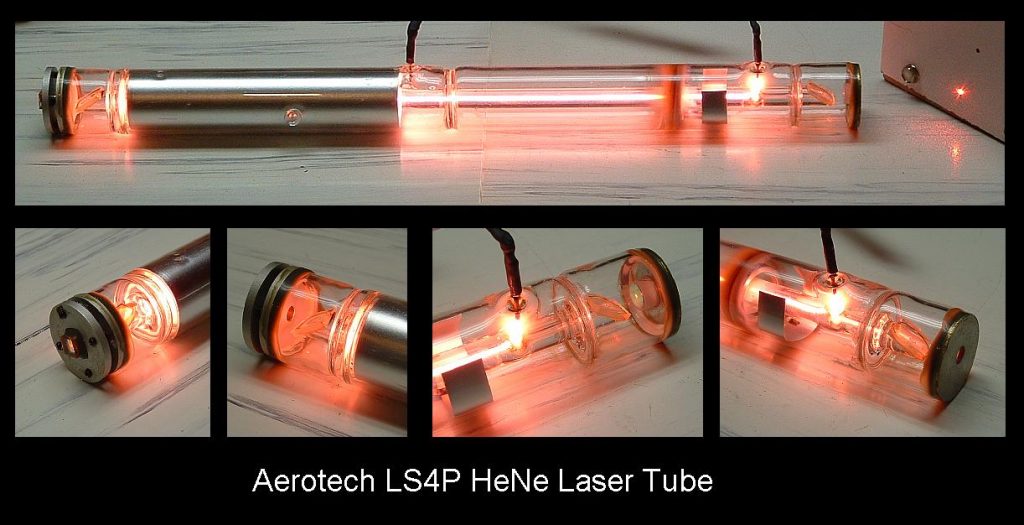
The Brewster windows appear to be glued in place. The OC is a normal 7 or 8 mm diameter curved mirror glued to the inside of the output aperture plate – basically a metal washer. The HR is a square, almost certainly planar mirror, glued to the outside of a 4 screw adjustable mount of sorts. Why is the HR square? Probably because it was cut from a large coated plate, rather than being coated individually. Why 4 screws instead of 3, making mirror adjustment much more of a pain? Another unsolved mystery of the Universe. 🙂 Though it’s not obvious from the photo, the Brewster windows aren’t quite oriented the same – the angle differs by perhaps 5 degrees – so the gain is already slightly reduced from what’s possible. However, I have been assured that this laser did meet specifications when new. The output is still polarized – probably half way in between – but the polarization extinction ratio is certainly lower than it could be. If the laser is still under warranty, it might be worth complaining. 😉 As can be seen, this sample still lases after re-firing the getter and then letting it run for several hours to allow the cathode to adsorb remaining impurities. The re-firing was actually done using a can crusher demonstration apparatus and the remains of the getter coating can be seen as the ugly brown ring encircling the tube just to the left of the anode connection. I don’t know whether the getter coating was any the worse for wear after that exciting event as I was not present.
What’s a “can crusher”? 🙂 Basically an electromagnetic pulse (EMP) generator: Discharge a really large high voltage capacitor bank into a couple of turns of wire wrapped around the tube (in this case). Since the getter electrode in this tube is conveniently oriented as a ring around the bore and thus acts as the secondary of a transformer, the high current discharge induced enough current to heat the ring to heat it instantly. I wish I could have witnessed that!
The output is only about 2 mW though, when the spec is 4 mW. Spectral line measurements of the discharge in the bore suggest that it’s low on helium and low pressure in general. A helium soak may be in its future.
I have a most likely even earlier Aerotech tube which is constructed along the same lines as the LS4P except that:
- It is nearly 3 times as long and twice the diameter.
- It has a side-arm cathode.
- The HR mirror is round instead of square.
- The bore is segmented as described in the section: Segmented HeNe Tubes.
It doesn’t lase and has a very pink discharge – running it now to see if that helps but not much hope by the time it gets that far. The tube originally put out 22 mW according to a hand-written sticker. I had picked it up on eBay in a big blue case and substituted another only slightly newer hard-sealed Aerotech tube which at least lased – 6 mW, wow. 🙂 Its problem appears to be a bad recipe for the gas fill, mirrors, or both.
A Really Old He-Ne Laser
This one isn’t really that strange but it must be quite old. The American Optical Corporation model 3100 was a red (632.8 nm, the usual wavelength) HeNe laser that used an external mirror (Brewster window) tube with a heated filament for the cathode.
The cover on one unit bears a sticker from El Don Engineering, 2876 Butternut, Ann Arbor, Michigan 48104, Phone: 1-313-973-0330. The laser was serviced and repaired on 9/28/80 and its output was 2.3 mW, TEM00. Another one had “Tube No. 1170, 2.1 mW TEM00, Jan. 13, 1970”. I wonder if they still exist. 🙂
The AO-3100 appears to be made by Gaertner (whoever they are/were, their model number is not known).
The bore is about 2.5 mm in diameter which is extremely wide for a red He-Ne laser. I would have expected it to be multi-mode (not TEM00). However, both samples say TEM00 and they must know. The Brewster windows are Epoxy-sealed so needless to say, most of these lasers no longer work (aside from the slight problem that when I received the first tube from one, it was in pieces. While I never expected it to work, being intact would have been nicer.)

Above shows a (dead) tube removed from an AO-3100 laser. Note the wide but thin-walled bore.
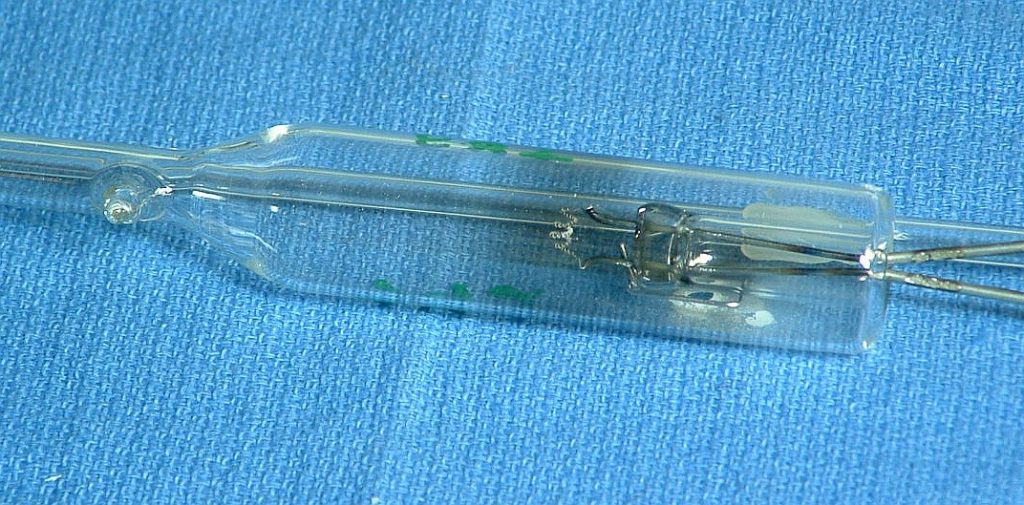
Above is a closeup of the filament and expired getter below it.
Not surprisingly, most of these lasers no longer lase or even light up since the tubes are soft-seal and long past their expiration dates. But if you happen to own a working time machine, it seems that Metrologic was supplying replacement tubes and power supplies for the AO-3100 as late as 1980. And, a bargain at only $225 and $100, respectively. You’ll have to pay with old bills though. 🙂
However, I now have obtained an AO-3100 that does still lase. More below.
Lasing specifications:
- Wavelength: 632.8 nm.
- Output power: 1 to 2 mW.
- Beam diameter: Approximately 2 mm.
- Divergence: Much less than 1mR (probably diffraction limited).
- Transverse mode: TEM00.
He-Ne laser tube:
- Bore diameter: 2.5 mm (~0.1″) ID, 3.5 mm (0.14″) OD.
- Bore length: 380 mm (~15″).
- Tube construction: All glass (seems like ordinary soft soda-lime type) except for Epoxy sealed Brewster windows – material unknown. The capillary is just a length of thin-walled glass tubing – not what you would expect in a self respecting HeNe tube (and this is one reason that bare tube didn’t survive mailing – that capillary is the only thing connecting the much heavier anode and cathode assemblies. Without being secured (in several places) to the mounting rail of the case, the tube would just about break from its own weight.
- Electrodes: Each is located in a side-arm parallel to the main tube and joined to it between the Brewster window and narrow capillary). The cathode is a heated tungsten coil filament. The anode is just the getter support wire and the getter itself.
Resonator:
- Distance between mirrors: 483 mm (approximately 19″)
- Mirrors: Soft-coated optics. 🙁 I found out the hard way and ruined the HR mirror which was only crudded up initially but now is unusable from the front. Reflection through the glass is still fine and I’ve gotten it to lase weakly from that side with a one-Brewster HeNe tube but what is that good for?!
- Resonator configuration: Nearly hemispherical with the bore near the front limiting the mode volume and assuring the TEM00 output. With the fixed diameter (non-tapered) bore, over half the possible gain is wasted since the mode volume is much smaller than the total volume of the bore. The mode diameter is about 2 mm at the output end but a small fraction of a mm at the other end.
- Mirror radii of curvature: HR is planar, OC is 50 cm. The outer surface of OC is probably curved to compensate for the diverging beam of the hemispherical resonator.
- Mirror mounts: Black anodized machined aluminum. Mirror optic (about 10 mm diameter) glued into threaded cylinder which screws into floating collar (sealed with plumber’s Teflon tape!). The collar presses against a resilient rubber O-ring and three setscrews adjust its position. This IS nice and stable but I wouldn’t want to be the person doing the initial alignment (though with the wide bore and/or ability to remove tube might not be that bad). A pair of rubber boots protect the Brewster windows and mirrors from the environment – somewhat.
- Resonator frame: The tube itself is mounted on an extruded U-section plate in three places along the thin sections only. How this is expected to survive any bumps let alone the shipping gorillas is not clear, but apparently it does. See more, below. The power supply components are mounted to the underside of the plate.
- Case: If the Spectra-Physics model 130 is the Sherman Tank of educational lasers, the AO model 3100 must be the donkey cart. 🙂 The top and bottom covers are made of about the thinnest sheet metal I’ve ever seen on a commercial product more expensive than a bread box. Bending it wouldn’t challenge a 90 pound weakling.
- Laser head dimensions: Total length is 533 mm (21″) and spacing between the holes for the optics mounts is 521 mm (20.5″).
Power Supply:
- Operating voltage: Basic 3 kV transformer/rectifier/filter/ballast resistor.
- Starting voltage: Additional high voltage output of transformer feeds clips on the outside of tube capillary. There is no other starting circuitry.
I have acquired a sample of the AO-3100 that was quite battle weary but the tube did survive cross-county shipping. The case, on the other hand, looks like it lost a fight with one of those Sherman Tanks. 🙂 It was bent and dented in multiple places. How the tube didn’t turn to a million bits of glass is amazing.
The better thing about this laser is that the discharge colour of the old soft-seal tube looks pretty good and there is still a very distinct getter spot. A measurement of the ratio of the He 587.56 nm and Ne 585.25 nm spectral lines in the discharge show that they are about equal in intensity. This means that the He:Ne fill pressure is still decent, though compared to a barcode scanner He-Ne laser tube I tested, about 1/2 the helium intensity. A helium soak might be in its future.
After realigning the mirrors and cleaning the Brewster windows, I now have 0.35 mW of red photons squirting out the front of the laser. Probably only the front mirror was misaligned originally, but since I had to remove them both to get the rubber Brewster covers off, realignment of both were required. Fortunately, getting an alignment laser beam through the wide bore was straightforward. The HR mirror mount was then installed and adjusted to return the alignment beam cleanly through the bore. The OC mirror mount was then installed and that’s when it became clear that its alignment was way off. Now I wonder who did that. 🙂 Once the alignment screws were tweaked to center its reflected spot, a bit of fiddling resulted in a weak beam. Some mirror walking and Brewster cleaning helped, but it’s not finished.
The discharge colour appears to be improving as it is run as well but output power has been decreasing as it is run. I hadn’t realized that the spec’d lifetime is only around 100 hours – and I’ve put on 5 or 10 percent of that just testing it! It might be a power supply problem though since it produces a nice bright beam for an instant when started, but then settles down to perhaps 100 uW on a good day. I do turn it on for a few seconds almost everyday just to keep it happy.
The photos for “Gaertner/American Optical 3100 Helium-Neon Laser 2” in the Laser Equipment Gallery are of this laser in action. The colour rendition of my digital camera isn’t very good. The colour in the main bore and larger sections of tubing actual should look close to that in normal He-Ne lasers. But the cathode glow (the bright blob) is actually more yellow, (though not quite the yellow in these photos. 🙂 The double coiled glowing hot filament is clearly visible in Views 03 to 05. A careful examination of Views 03 and 06 reveals the scatter from the Brewster windows at each end of the tube. Note the large difference in scatter size due to the hemispherical resonator. View 07 shows that there is indeed a beam from this laser (if that wasn’t obvious from the Brewster windows), though due to its relatively low power, bore light is competing for attention.
I now run this laser for a short time on roughly a weekly basis just to keep it happy. I’ve never reinstalled the boots, so Brewster cleaning is required every few weeks. The maximum power is now only about 0.2 mW and seemed to be declining with extended run time. Once one realizes that the rated life is only 100 hours or so, it’s likely that the few hours I ran it sucked up a substantial percentage of its life. However, the short runs don’t seem to be hurting it much. This laser was acquired in July, 2005 and it had been over 2 years now without obvious degradation.
However, as of 2009, it lights up with an seemingly normal discharge colour but will not lase despite repeated B-window cleaning. It’s possible that the mirrors have become contaminated due to not being sealed, or even degraded since they are soft coated. Eventually, I’ll deal with that.
The Dual Colour Yellow/Orange He-Ne Laser Tube
Multiline operation is common in ion lasers where up to a dozen or more wavelengths may be produced simultaneously depending on the optics and tube current. However, most HeNe lasers operate at a single wavelength. The only commercial HeNe lasers I know of that are designed to produce more than one wavelength simultaneously are manufactured by Research Electro-Optics (REO). They have 1,152/3,390 nm and 1,523/632.8 nm models.
Through screwups in manufacturing (incorrect mirror formula, extra “hot” emission, etc.), an occasional He-Ne laser may produce weak lasing at one or more (“rogue”) wavelengths other than those for which it was designed. For red tubes, the most likely spurious wavelength is a deeper red at 640 nm since it is also a fairly high gain line. For a low gain yellow laser, orange is most likely since it is a relatively close wavelength and any goofup with the mirror reflectivities may allow it to lase.
I have a tube made by Melles Griot, model number 05-LYR-170, which is about 420 mm long and 37 mm in diameter and can be seen as the middle tube in the photo below:
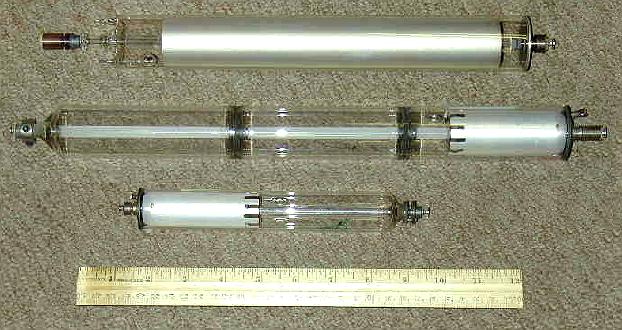
Its only unusual physical characteristics are that the bore has a frosted exterior appearance (what you see in the photo is not the reflection of a fluorescent lamp but the actual bore). Apparently, larger Melles Griot He-Ne tubes are now made with this type of bore – it is centerless ground for precise fit in the bore support. I don’t know if the inside is also frosted; that is supposed to reduce ring artefacts. And, of course, the mirrors have a different coating for the non-red wavelengths.
According to the Melles Griot catalogue, this is a He-Ne laser tube operating at 594.1 nm with a rated output of 2 mW. However, my sample definitely operates at both the yellow (594.1 nm) and orange (604.6 nm) wavelengths (confirmed with a diffraction grating) – to some extent when it feels like it. The output at the OC-end of the tube is weighted more towards yellow and has a power output of up to 4 mW or more (you’ll see why I say ‘up to’ in a minute). The output at the HR-end of the tube has mostly orange and does a maximum of about 1 mW. Gently pressing on the mirrors affects the power output as expected but also varies the relative intensities of yellow and orange in non-obvious ways. They also vary on their own. The mirror alignment is very critical and the point of optimum alignment isn’t constant. In short, very little about this tube is well behaved. 🙂
Why there should be this much leakage through the HR is puzzling. The mirror is definitely not designed for outputting a secondary beam or something like that as there is no AR coating on its outer surface. Thus, that 1 mW is totally wasted. Perhaps, this was an unsuccessful attempt to kill any orange output from the OC. The OC’s appearance is similar to that of a broadband coated He-Ne HR – light gold in reflection, blue/green in transmission. The HR appears similar to one for a green He-Ne laser – light metallic green in reflection, deep magenta in transmission. (However, it’s hard to see the transmission colour in the intact tube. The OC may be more toward deep blue and the HR may be more toward purple.)
As would be expected where two lines are competing for attention in a low gain laser like this, the output is not very stable. As the tube warms up and expands – or just for no apparent reason – the power output and ratio of yellow to orange will gradually change by a factor of up to 10:1. Very gently pressing on either mirror (using an insulated stick for the anode one!) will generally restore maximum power but the amount and direction of required pressure is for all intents and purposes, a random quantity. If the mirror adjuster/locking collar is tweaked for maximum output at any given time, 5 minutes later, the output may be at a minimum or anywhere in between.
I surmise – as yet unconfirmed – that at any given moment, the yellow and orange output beams will tend to have orthogonal polarizations. But, as the distance between the mirrors changes, mode cycling will result in the somewhat random and unpredictable shifting of relative and total output power as the next higher mode for one colour competes with the opposite polarized mode of the other. Is that hand waving or what? 🙂
A few strong magnets placed along-side the tube reduce this variation somewhat. I’m hoping that adding some thermal control (e.g., installing the tube in an aluminium cylinder or enclosed case) may help as well. I was even contemplating the construction of a servo system that would dither the cathode-end mirror mount to determine the offset direction that increases output and adjusts the average offset to maximize the output. This might have to be tuned for yellow or orange – an exclusive OR, I don’t know if maximizing total optical power will also maximize each colour individually.
Using an external red HR or OC (99 percent) mirror placed behind the tube’s HR mirror, I was able to obtain red at 632.8 nm as well as a weak output at the other orange line (611.9 nm), and at times, all four colours were lasing simultaneously. 🙂
(From: Steve Roberts.)
Ah, the Melles Griot defects… These show up from time to time and are highly prized in the light show community for digitizing stations and personal home lumia displays.
The yellow/orange combo is not a goof. I’ve seen a 7 mW version of that that was absolutely beautiful, but rejected because it was too hot. It’s probably slight differences in the length of the tube or bore size. They cut them for a given mode spacing, but fill them all at once with the same gas mixture. A few companies do make dual line tubes, but you can imagine the initial cost is murder.
I used to have a short tube that switched from red (632.8 nm) to orange (611.9 nm) that appeared brighter then the red when it felt like it.
I sometimes wonder if there are a few more He-Ne transitions we don’t know about. I know they exist in ion lasers. I have seen a 575 nm yellow line in krypton that’s not on the manufacturer’s data and a red in Kr that is between 633 and 647 nm. I had that red in my own laser. 575 nm is preferred for show lasers because it doesn’t share transitions with 647 nm like 568 nm does.
When I was interviewing at AVI in Florida they used 4 colour 4 scan pair projectors for digitizing – 6 mW of yellow, 5 mW of green, and 8 mW of red, all from He-Ne lasers. The blue came up from an ILT ion laser in the basement to each of the four stations via optical fiber. The guy who owned AVI said if you call Melles Griot and ask nicely they will grade some tubes for you for a slight extra cost. Methinks they make all the special colours up and tune them in power somehow, so they can make a price differential, those lines should be consistent by now.
Every two years of so it seems Melles Griot cleans out their scrap pile, and somebody always seems to get there hands on them, grades them and sells em.
(From: Daniel Ames (Dlames2@aol.com).)
The yellow and orange He-Ne energy transitions are very similar and possibly competing with each other, especially if the optics are questionable. I have learned that Melles Griot and other He-Ne laser manufacturers sometimes suffer from costly mistake on a batch of tubes due to the optics being incorrectly matched to the tube and/or the optics themselves not being correct for the desired output wavelength. One such batch was supposed to be the common red (632.8 nm) but the optics actually caused the gain of the orange to be high enough that the output contained both red and orange (611.9 nm). Then I believe they are rejected and tossed out, only to be saved by professional dumpster divers to show up on eBay or elsewhere. Actually, these misfits such as the yellow/orange tube can be quite fascinating. It would be interesting to shine a 632.8 nm red He-Ne laser right through the bore of that tube while powered and see what colour the output is. I have been told that if you shine a red He-Ne through a green He-Ne that it will cause the green wavelength to cease. I have not had this opportunity to try this, so I do not know for sure what really happens, maybe the red just overpowered the green beam. This could be verified with 60 degree prism or diffraction grating on the beam exiting the opposite end of the green tube. Happy beaming. 🙂
(From: Sam.)
I have tried the experiment of shining a red He-Ne laser straight down the bore of a green He-Ne laser (my green One-Brewster tube setup). I could detect no significant effect using a low power (1 or 2 mW) laser. This isn’t surprising given that the intracavity power of the green laser was probably in the hundreds of mW range so the loss from the red beam would be small in a relative sense. However, wavelength competition effects are quite real as evidenced from experiments with the two colour 05-LYR-170 tube.
The Weird Three-Color PMS He-Ne Laser Head
I picked up a surplus PMS (now Research Electro-Optics) LHYR-0100M HeNe laser head (with power supply) on eBay for a whopping $30 including shipping. This model supposedly produces a pure yellow (594.1 nm) multimode beam with a minimum power output of 1 mW. See REO LHYR-0100M. But mine is happily outputting the yellow (594.1 nm) and two orange (604.6 and 611.9 nm) lines (determined by splitting the beam with a diffraction grating, something I routinely do with all newly acquired He-Ne lasers!).
Its actual total power output after warm up is over 2.50 mW. The 594.1 nm (most intense, LG01/TEM01* doughnut) and 604.6 nm (LG01/TEM01* or TEM10 depending on its mood) are relatively stable but the 611.9 nm (least intense, TEM01) visibly fluctuates. Nonetheless, overall power stability and mode cycling behaviour are similar to that of a typical medium power red (632.8 nm) HeNe laser, which contrasts dramatically with the very unstable yellow/orange Melles Griot laser described above. REO does have a couple of dual wavelength He-Ne laser heads listed but nothing like this. They are 1,152/3,391 nm and 1,523/632.8 nm.
There is also an additional 2 pin connector on this laser head. The resistance between pins is about 20 ohms and I assume it to be a heater on the OC mirror, though driving it with about 10 V had no detectable effect whatsoever. (This is supposedly used to prevent the formation of “colour centers” in the mirror coating. Many older PMS lasers have the heaters and I’ve never seen any noticeable effect on any of those I’ve tested either!)
However, I wonder if there is also some screwup in the REO model descriptions as the size of this laser head actually matches that of the REO LHYR-0200M, being almost 17″ in length rather than the 13″ listed for the LHYR-0100M. I kind of doubt that shorter length can be accounted for by dramatic improvements in HeNe laser technology since my sample was manufactured (1988), though I suppose that’s a possibility. But the electrical specifications of the two lasers are supposed to be identical, which doesn’t make sense and I don’t believe in coincidences. 🙂 And the output power of my sample peaks at 6.5 mA which isn’t consistent with the specs for either the LHYR-0100M or LHYR-0200M which are both 5.25 mA.
I’ve since tested a pair of PMS/REO mode LHOR-0150M laser heads. Both of these produce relatively stable triple wavelengths, though the “colour” balance differs:
- Head 1: 3.4 mW total in the approximate ratio 18:16:34 (594:605:612 nm).
- Head 2: 4.4 mW total in the approximate ratio 84:35:28 (594:605:612 nm).
The ratios change somewhat during mode sweep but not anything sudden or dramatic, and generally not noticeable with an actual measurement.
I’ve also seen several double-ended LHOR tubes with similar characteristics, in addition to the one with the strange 609.0x nm line, below.
The Weird Four-Color REO He-Ne Laser Tube
(With contributions from: Sean Reeber and Steve Roberts.)
And this one is only supposed to be 611.9 nm orange. However, it’s doing stable 604.6 nm (orange toward yellow), 594.1 nm (yellow), AND a wavelength that few if any people have ever seen in a He-Ne laser, which appears to be between 608.9 and 609.1 nm (orange). The tube is labelled LTOR-0150ODE, which would normally mean 1.5 mW (rated) 611.9 nm (orange). But we know and love PMS/REO – many of their “other colour” He-Ne tubes are not what they are spec’d to be. This is a bare tube which by design (I assume) has about equal output from both ends. (Confirmed because both ends have the strange extra optic glued to the mirror glass, presumably to correct divergence.) Originally, it was misaligned, so the total output power was only about 2 mW consisting of the three common lines – 611.9, 604.6, and 594.1 nm. (Already out of spec but not unusual for REO.) After aligning the OC mirror with a car key (!!), it now produces almost 4 mW total output from both ends. AND a lasing line popped up between 611.9 and 604.6 nm. At first I thought it was simply an artefact of the diffraction grating since it was too unstable to really analyze in detail. But then it came on and stayed on for almost an hour during which photos could be taken of the lasing line spectrum and the wavelength could be measured precisely. The wavelength of the mystery line has now been determined in several ways:
- A diffraction grating was used to project the beam onto a white wall and the spots were photographed. Care was taken to assure that both the beam and camera were perpendicular to the wall. See below:
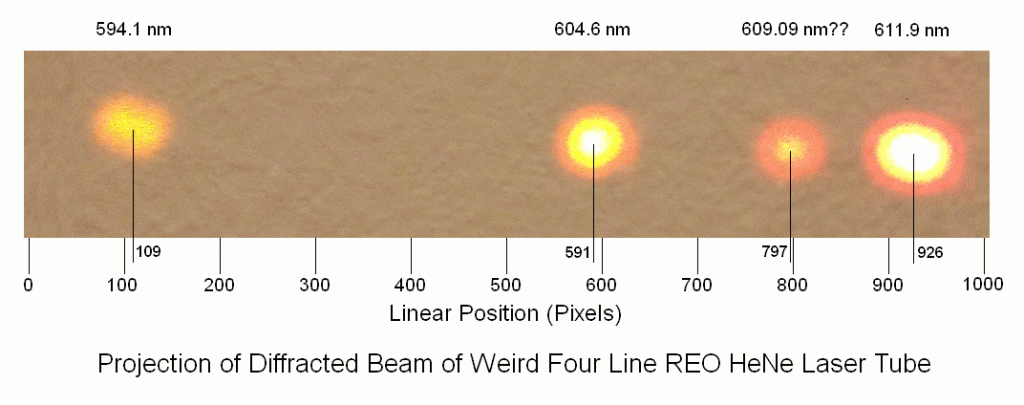
Projection of Diffracted Beam of Weird Four Line REO He-Ne Laser Tube The position scale is in pixels with the centroids of each spot also labelled. The wavelength of the mystery line was calculated based on interpolating between the spots of known wavelength. Using 604.6 and 611.9 nm or 594.1 and 611.9 nm result in values within less than 0.01 nm of each-other. Result: 609.05 nm.
- Also using a diffraction grating but measuring the distance of the spots on the wall using a tape measure. Result: 609.09 nm. With the known parameters, this was computed using the exact difrraction grating equation.
- Someone with another REO tube used a USB spectrometer (what a concept!) as shown below:
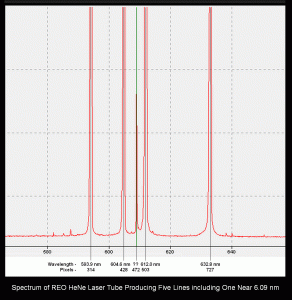
Spectrum of REO He-Ne Tube Producing Five Lines including One Near 609 nm This may be one of the “three mirror cavity” assemblies described in the section: The PMS/REO External Resonator Particle Counter He-Ne Laser. As can be seen, there are hints of a few other lines, which would be expected with that tube but none in close proximity to the mystery line. Result: 608.9 nm. Although such spectrometers aren’t always very precise, they are linear so estimating the unknown wavelength based on known ones is accurate. And prior to knowing this result, placing the cursor over it resulted in a similar value.
It’s difficult to argue with the spectrometer, especially using the known wavelengths for the nearby lines as calibration references.
A search of the NIST database and other sources has shown that there is a transition at 609.5 nm between the 2P4 to 1S4. This is not out of the question, though I do believe my measurements to have an uncertainly of less than 0.2 nm. However, if it is indeed 609.6 nm then there is another mystery: 2S4 is the lower lasing level for 632.8 nm (common red). But there is normally no lasing at 632.8 nm for 2 of these lasers! (Though 632.8 nm can be produced using external mirrors.) So, if that wavelength is accurate and originates there, it may be another Raman transition. The source of the peculiar lasing line is unknown. It has not turned up in a literature search for lasing wavelengths so far. However, in “Gas Lasers”, edited by Masamori Endo, Robert F. Walter, pg. 501, there is a diagram with a radiative decay transition at 609.6 nm. This should not be a lasing line though. See link for the graph from “Gas Lasers” Gas Lasers: The Helium-Neon Energy Level Diagram. But a lasing line at around 610 nm using 2P4 to 1S4 does turn up elsewhere.
Could there actually be two lines near 609 nm and the one seen here is previously undiscovered? 🙂 While this is hardly likely based on the amount of research done in the 1960s on finding every HeNe line that could lase, it’s not totally out of the question. It is far enough from the 609.6 nm knwon line to rule this out with a high degree of certainty. Perhaps ~609 nm has been seen by many researches who never measured it precisely assuming it was the 609.6 nm line.
Another possibility is that the mystery line is from some gas contamination. Here are some possible emission lines close to the unknown lasing line:
- N II = 608.654.
- Ar I = 609.0785 (!!).
- O IV = 609.253.
- Xe I = 609.338.
- Xe II = 609.350.
- Ne I = 609.616.
The most likely is argon, with its emission line at 609.0785 nm, within +/-0.1 nm of the mystery line. It could be that REO used neon intended for NE2 indicator lamps, which apparently may have 0.5% Ar to reduce the starting voltage. Or, perhaps they added Ar for that purpose figuring it would make no difference in lasing – which would be true in most cases, and any additional lines would go unnoticed by 99.9% of users.
Stay tuned. The jury is still out on this one. 🙂
The Ancient Hughes He-Ne Laser Head
These old laser heads have been showing up in various places including eBay with one particular model number being: 3184H. See below:
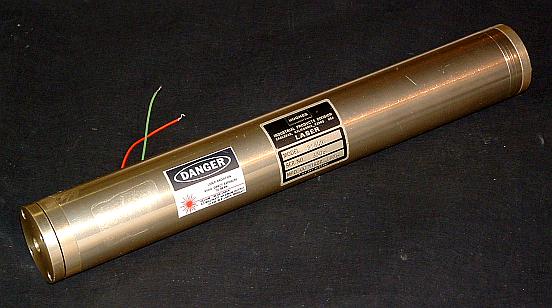
. They date from the 1970s, some possibly quite early in the decade. Their external appearance is unremarkable – a heavy gold-coloured cylinder about 12.25 inches long and 1.75 inches in diameter, with end-plates each attached with 4 cap screws. Power connections to most are via a pair of rather thin red and green wires (with red being the positive input), though later ones may use an Alden cable. There is a 30K ohm, 5 W metal film internal ballast resistor which by itself is insufficient for stable operation with most power supplies – an external ballast of 50K to 75K is required. The power supply that appears to be intended to drive this laser head has a 60K ballast on board.
But the remarkable thing about these laser heads revolves around what is inside: A two-Brewster He-Ne laser tube! Except for some very early units, the tips of the 2-B tube extend to very nearly touch the mirror plates. On some early ones, the tube is about an inch shorter. (I don’t know if this is just a physical difference or whether the newer tubes are actually slightly higher power.) So, these are really external mirror lasers in a nice compact stable package. See below:
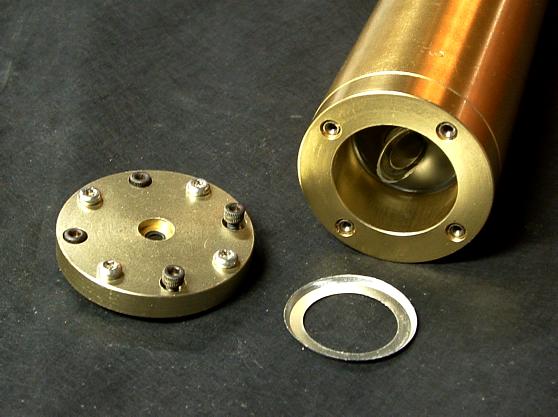

The end-plates press against aluminium gaskets which allow for mirror adjustment as well as providing a mostly decent environmental seal. The mirror glass is held in place in the end-plate with an aluminium ring press-fit against a rubber cushion. Note the threaded inserts to provide steel-on-steel contact for the adjustment screws. The Brewster window and potting material can be seen within the massive aluminium cylinder – the wall thickness of the sections near each end is at least 5/16ths inch! It’s actually made up of 3 pieces (in addition to the end-plates) press-fit together along with a rubber O-ring and an additional rubber ring (maybe just squirted in before completing the press-fit) for sealing. The center section has thinner walls and I found out that clamping it in a vice will crunch the tube. 🙁 But at least the broken heads still make decent hammers. 🙂 The actual tube is the typical Hughes-style but with B-windows at both ends. Although the potting material is soft rubber and not RTV, it appears to mostly fill the inner space, just allowing the Brewster stem at the anode/wiring-end of the tube to poke out and nearly covering the cathode-end, so removing the tube intact would be a challenge. More below.
Several other models may also contain 2-B tubes like this including the 3072H, 3176H, 3178H, 3193H, and 3194H.
Unfortunately, dating from the 1970s, most samples are deader than the standard door nail. They might light up but don’t lase. I acquired two of these awhile ago. One, from 1976, appeared to have approximately the correct discharge colour (as best as I can determine viewing it from the end) and the tube voltage seemed reasonable. But, no red photons no matter what I’ve tried. Another, from 1979, did start a couple years ago, though the discharge colour and tube voltage characteristics were obviously wrong. But now it only flashes, indicating that it’s nearly up to air. However, several of the oldest lasers, dating from the early 1970s, have survived and lase and even produce an output power not much different than what was measured in 1973, the last time they were tested! The beam is TEM00 with low divergence and less scatter than many modern He-Ne lasers. I suspect that for those fortunate individuals, the Brewster windows were optically contacted instead of being sealed with Epoxy.
One of the working heads I tested outputs about 3.5 mW at 6.5mA with an operating voltage to the head of about 1,610v. The test power in 1973 was 3.4mW. Based on the 4 in the model number and a CDRH sticker rating of 6.5mW, I suspect that the rated output power is actually 4 mW. Power continues to increase slightly above 6.5mA. This may mean that either the optimal current is higher, or more likely, that the tube is low on helium or has some other slight gas fill problem, or it’s just high mileage. (Although the power supply that apparently went with these heads is not very well regulated, its behaviour suggests that 6.5mA is correct.) Due to the way the tube is potted inside the metal cylinder, there is no way to easily assess the discharge spectrum to evaluate the gas fill without test instruments.
The mirrors appear to be hard-coated with the HR being flat and the OC having an RoC of about 30 cm. This results in a nearly hemispherical resonator with a mirror spacing just under 30 cm, confirmed by the very small spot visible on the HR mirror when the laser is operating. The OC is AR coated on its outer surface (though it is not as robust as modern AR coatings), and on most of the laser heads, the HR is fine-ground on its outer surface.
Interestingly, the bore of the 3184H appears to be tapered and is wider at the OC-end than at the HR-end. This makes sense to more closely match the mode volume of the hemispherical resonator and thus increase the gain slightly. A tapered bore was apparently an optimization that was popular in the early days of He-Ne lasers but went out of fashion due to its higher cost compared to using a uniform size capillary tube for the bore. I’ve only come across a tapered bore (or at least noticed it) in one modern-style He-Ne laser tube, a Melles Griot 05-LHP-170, manufacturing date unknown but it has a serial number of 675P – sounds kind of old! With this asymmetry, the HR and OC cannot simply be swapped without likely seeing a severe penalty in output power. It also would likely not be advantageous to use a confocal or any other symmetric configuration. However, going to a long-radius hemispherical resonator might work even better than the existing arrangement.
With 4 screws holding the end-plates in place against the aluminium gasket, mirror adjustment is somewhat awkward but with persistence, optimal alignment including mirror walking can be performed relatively quickly. However, the aluminium gasket isn’t ideal, so for testing, I’ve replaced it with a rubber O-ring to provide some real compliance. That is, until I decide what to do with the 2-B tube inside! 🙂
There apparently were some of these for other wavelengths. I’ve found a (dead) sample of a 3176 that was probably for 1,152 nm as the mirrors are highly transparent at all visible wavelengths but without the greenish tint typical of 1,523 nm mirrors. I suppose it’s possible someone replaced the mirrors but they appear to be original.
Where one is really determined to get the tube out, here is more info on what’s involved. But why bother? Aside from aesthetics, it’s perfectly happy in there and very well protected. The risk of destroying the tube may not be worth the rewards. The press-fit end-sections must be pulled straight out (not twisted) with something along the lines of a gear puller as they are a very tight metal-to-metal press fit with ridges all around. Or, they can be carefully cut off with a metal cutting lathe or band saw. But serious vibrations will likely destroy the tube. Then, the rubber potting material would have to be chipped/gouged/cut/sliced away to actually extract the tube. Then all the remnents of the rubber stuff must be removed from the tube.
Having said that, I was able to get the end-sections off of a dead laser head without serious tools. (I’m not about to risk a good one!) Since the center section has a slightly larger outside diameter than the end-sections, an aluminium He-Ne laser head clamp tightened just snug around the end-section provided a way of pressing on the center section to pull the end-sections free. Four clearance holes were drilled in a 1/2″ thick piece of aluminium plate and 4-40 screws were then passed through these holes and threaded into the laser head. By carefully tightening these screws in a cyclic manner (e.g., 1,2,3,4,1,2…), the end-section could be pulled out about 1/8″. Once this was done, the He-Ne head clamp was removed and shorter screws were used to attach the 1/2″ plate directly to the head. With the plate clamped in a vice, the entire head could be worked back and forth until it came free. (Alternatively spacer plates and/or shorter screws could be added/substituted to continue the original process until the end-section comes free.) This was not fun, a set of screws survived for only about one end-section, and as noted, this is really only the beginning of the tube extraction process. I have not yet attempted to go any further. But someone else has succeeded in removing one of these tubes intact. Apparently it wasn’t much fun.
I’ve recently come across a 3170H, which is similar in construction to the heads described above – but on steroids. It is 22-3/4″ long by 2-1/4″ diameter with a thick-walled cylinder for its entire length. The mirror adjustments are equally mediocre with the same aluminium foil seals. The 2-B tube inside is about 22″ from Brewster tip to Brewster tip. It had a manufacturing date of 1978. Unfortunately, the HV cable was cut flush with the body of the cylinder, so there was no chance of being able to safely apply power, but using an Oudin coil, it does ionize with possibly decent colour. It must have been good for 10 or 15 mW.
And I was given a 3178H that is under 9 inches in length with an Alden cable coming out the side instead of the red and green wires, but is otherwise identical to the 3184H. See below:
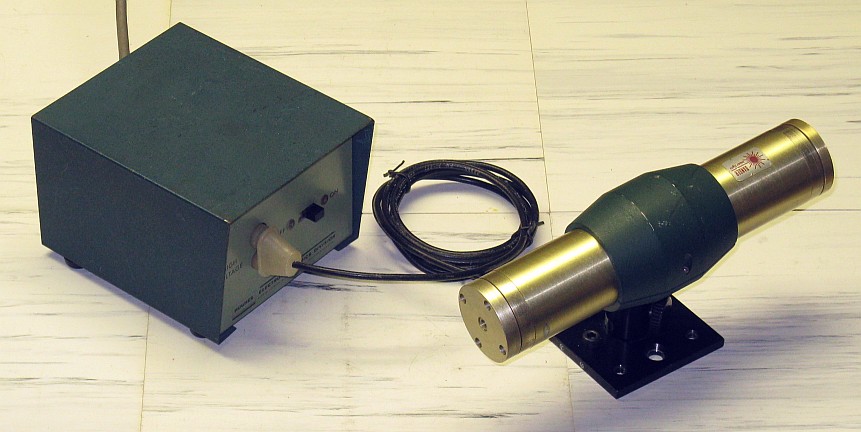
It produces over 1mW at 6.5mA (a bit under 0.9mW on 5mA), which is probably close to the power when new.
The PMS/REO External Resonator Particle Counter He-Ne Laser
This is a particle counter assembly labelled: ULPC-3001-CPC, 18861-1-16 with the actual He-Ne laser tube labelled: LB/5T/1M/E(HS), PMS-4877P-3594. The unit is shown in PMS/REO ULPC-3001 Particle Counter HeNe Laser Assembly. When I found it on eBay, the listing was for a One-Brewster tube. However, this one is really strange. For one thing, it is not a Brewster tube but rather a somewhat normal internal mirror He-Ne laser tube. Well, at least normal by PMS/REO standards – mostly metal with Hughes-style glasswork at the anode-end. Except it is a very multimode tube having an output that is rather high (greater than 7.5 mW) for its length (11 inches between mirrors) and power requirements 1,900 V/5.25mA. That would be only modestly interesting. But there is an additional mirror beyond the OC (inside in the area between the two red dots next to the red sticker at the left) which forms an external resonant cavity with the (internal) OC mirror. The external HR mirror is actually coated on the end of a transparent crystal about 1 cm in length, mounted by a pair of electrodes attached to opposite sides which most likely is piezo-electrically active and probably changes length when a voltage is applied to it. A photodiode is mounted beyond the crystal (far left in photo). The signal from the photodiode shows resonance effects at several relatively low frequencies (two dominant ones are around 175 and 350 kHz). The waste beam from the He-Ne laser HR mirror can actually be seen to flicker and become much lower in power at the resonance points. The crystal and photodiode may be used to dither the output so that the effects of the inherent laser noise are eliminated. I doubt its supposed to be a very high frequency because the wires to the electrodes are not shielded. It might also be used in a feedback loop at low frequencies.
PMS has a patent for this setup – U.S. Patent #4,594,715: Laser With Stabilized External Passive Cavity. By linearly oscillating the external mirror at a modest frequency (enough to produce a few cm/sec of movement), the resulting Doppler broadening of the wavelength spectrum will be sufficient to effectively decouple the external cavity from the active cavity. This gets around the stability issues present with open cavity (e.g., Brewster window) particle counter designs. There is a great deal of information in the patent on this and other principles of operation.
Any hapless particles that may pass through the beam in the cavity between the OC of the HeNe laser tube and the external mirror will result in scatter detectable from the side. A large reflector and aspheric lens collects the side-scatter and focuses it on another photodiode (under yellow CAUTION sticker). There is a preamplifier in the box.
It gets better. Viewing the waste beam out the unused HR-end of the tube (far right) with a diffraction grating reveals that the tube is lasing on the normal red line, but also on both of the HeNe orange lines (604.6 nm and 611.9 nm), three other red lines (629.4 nm, 635.2 nm, and 640 nm), *and* on the very rare Raman shifted red line at 650 nm. And there may be others but it’s difficult to resolve them since the beam is multimode and the spectra cannot be focused to small spots. Here’s a photo of spectrum:
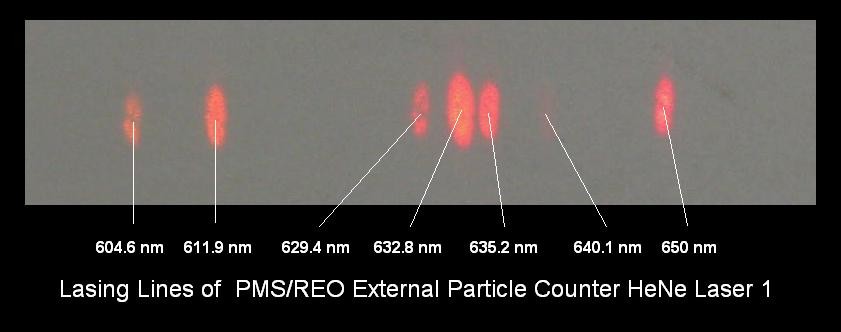
From left to right, the wavelengths are: 604.6 nm, 611.9 nm, 629.4 nm, 632.8 nm, 635.2 nm, 640 nm (very weak), and 650 nm. The 650 nm is actually probably the second strongest after 632.8 nm. How many 7 line He-Ne lasers have you seen? 🙂 This is similar but even better than what I’ve observed in my experiments using external mirrors with normal internal mirror He-Ne laser tubes although this one seems particularly stable with little obvious variation in the intensities of the lines, at least over a period of a few minutes. Obtaining the 650 mm line is particularly unusual, especially since it is so stable. These non-632.8 nm lines are probably not an objective of the design but are just an interesting artefact.
In fact, testing much later with a Rees laser spectrum analyzer, a weak line at around 652 nm is also present some of the time. See the section:
I have estimated the reflectivities for the three mirrors which are in this laser. These values are based on measurements of the output power of the He-Ne laser tube without the external mirror (about 8 mW after warm up) and the assumption that the internal OC is about 99 percent:
Power with external HR?
Mirror Description Reflectivity No Yes
----------------------------------------------------------------------
HeNe laser tube HR 99.99% 0.9 mW 1.00 mW
HeNe laser tube OC 99% (assumed) 8.00 mW 80.00 mW
External HR 99.9% -- 0.09 mW
The “Power” refers to the optical power passed by the specified mirror depending on whether the external HR mirror is present and aligned. In the case of the He-Ne laser tube OC with the external HR, this is the circulating power in the external cavity which is what’s available for the particle scatter. Note that the circulating power inside the He-Ne laser tube is around 10 WATTS but isn’t accessible.
I obtained another particle counter assembly with an internal mirror He-Ne laser tube and external resonator. However, there were some differences, most notably an electronics PCB attached to the back of the resonator, and possibly a PZT instead of EO device for cavity length dithering. The tube in this one must be soft-sealed as it arrived with a putrid blue/pink discharge requiring more than a week of run time to clean up until the output power levelled off at about 1.2 mW (50 percent higher than the other laser). It then produced 6 of the same 7 lines through the HR (all but 604 nm). The 650 nm Raman line had been growing steadily during cleanup and is as intense or perhaps even more intense than the 633 nm line. It is also rock stable which is supposed to be impossible. The 640 nm line is very weak, possibly as a result of mode competition with the Raman line but that’s just a wild guess. 🙂 There is also a very weak output at around 652 nm – probably another Raman line or something more exotic. But it is only there sporadically. See below:
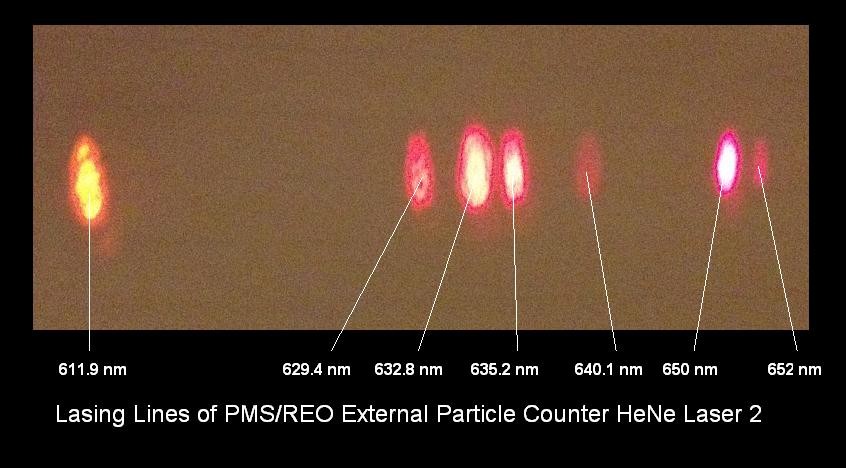
Too bad the colour rendition of the digital camera is so poor.
And here are some comments on particle counter technology:
(From: Phil Hobbs (pcdh@us.ibm.com).)
There exist particle counters using external resonant cavities, and also intracavity Nd:YAG setups. Intracavity measurements *look* as though they give you amazing sensitivity, but they usually don’t. Not only is the circulating power amazingly sensitive to temperature gradients and tiny amounts of schlieren from air currents, but the signal you get is wildly non-linear and highly position-dependent. Intracavity measurements are a great way to lose sleep and hair. Passive cavities are usually much better, and non-resonant multipass cells are better still.
The Ohmeda Raman Gas Analyzer REO One-Brewster Laser
This unit is somewhat similar to a particle counter in that there is a very high-Q 1-B He-Ne laser tube with a second HR mirror some distance away. In between is a space for an absolute filtered unknown gas to pass through with 8 “viewing ports” – 4 on each side. Sensitive photon counting detectors would normally go behind individual narrow band filters, each with a different center wavelength.
Raman spectroscopy is used to identify gases by passing a laser beam through the unknown sample. Raman scattering results in a shift toward longer wavelengths depending on the atomic/molecular composition of the gas. By measuring the intensity of the Raman scatter at several longer wavelengths, the gas composition can be determined. For these units, the relevant gases were apparently N2, O2, and N2O based on “linearization constants” printed on a label on the lasers.
To get any sort of sensitivity, the beam must be high power since a very small percentage of photons actually undergo the Raman shift. For the Ohmeda unit, this is achieved by utilizing the intracavity power between 2 super polished HR mirrors and super-polished Brewster window. While I don’t know for sure what the intracavity power should be, based on tests of the mirror reflectivities and output power with an external OC mirror with known reflectivity, it is at least several watts and could be over 100W when using the original exteranl HR mirror!
The relevant patents include:
- U.S. Patent #RE34,153: Molecular Gas Analysis by Raman Scattering in Intracavity Laser Configuration
- U.S. Patent #5,818,579: Raman Gas Analysis System with Cavity/Boss Assembly for Precision Optical Alignment
- U.S. Patent #5,912,734: Raman Gas Analysis System with Ball and Socket Assembly for Precision Optical Alignment
The first one describes the principles of Raman spectroscopy though the actual drawings do not correspond to the Ohmeda laser assembly. But the other two have diagrams which closely match the specimens I have, though I’m not sure which they are.
A photo of a mostly complete unit is shown below:
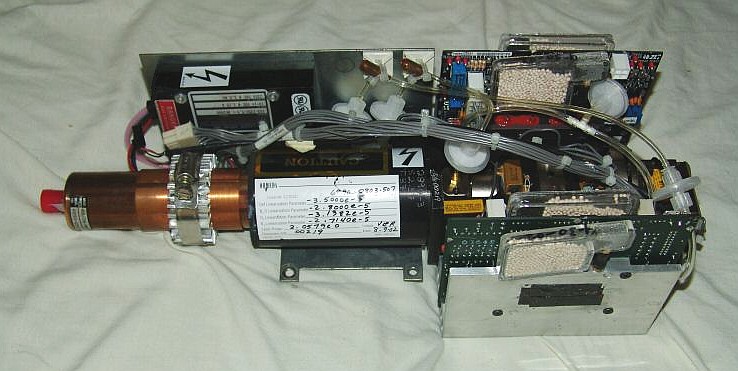
The metal He-Ne laser tube can be seen poking out the left side with the red cap covering its internal HR mirror. The brick power supply is behind it. The tuning prism assembly is at the right, partially hidden by an absolute filter and one of the detector PCBs. That elaborate set of filters and desiccant containers is designed to eliminate *all* particles and condensible vapours from the laser cavity, which must remain perfectly clean. I’m not really sure why the heatsink is clamped to the laser tube. It doesn’t get *that* hot. 🙂
The laser tube, Brewster prism, and external mirror are probably made by REO, Inc.. (Other parts of the assembly may be made by REO as well.) The tube looks like a slightly shorter version of the REO/PMS tunable 1-B tubes, but its internal HR mirror is coated so that in conjunction with the HR mirror at the other end of the cavity, the reflectance for 632.8 nm is maximized. Using a 60 cm RoC OC mirror with a reflectance of approximately 98 percent at 632.8 nm, the laser produces about 5.4 mW, multimode. I assume that with an optimal OC mirror, the power would be somewhat higher. (This test was done without the Brewster prism assembly. There would be some loss with the prism present in the cavity.)
At 5 mW – implying 250mW of intracavity power with the 98 percent OC – the waste beam is about 5 uW and the reflectivity of the internal HR mirror is thus about 99.998 percent. There is very little scatter visible on the B-window under these conditions. (I did have to clean it, but there is a handy access port that can be used for this purpose.) If there were no other losses, putting a similar HR at the other end would result in 125 W of intracavity power! Of course, this is impossible as there ARE other losses, but it is likely to be several watts and perhaps much more. With an SP-084 HR, the output from this mirror was about 0.5 mW and the output from the internal HR was 32uW corresponding to about 1.5W of intracavity power. Not too shabby. But with the REO HR (and Brewster prism), the waste beam power for 633nm was a whopping 122uW implying about 6 WATTs inside. Not too shabby at all. 🙂 I have cleaned the Brewster prism with no significant change in performance. However, a careful cleaning of all three surfaces would almost certainly improve things some more, especially for this case. Interestingly, with the REO mirrors, the beams exiting the laser appears to close to, if not pure, TEM00.
When used in the normal way, there is a 632.8 nm narrow band filter between the external mirror and a silicon photodiode. So, that is almost certainly used to monitor the power transmitted by that mirror, and by inference, intracavity power.
The 632.8 nm intracavity power would no doubt be greater without the prism but that’s where it gets interesting. With the prism in place, the wavelength is tunable with both orange wavelengths being easily selectable for 2 of the lasers. (The 604.6 nm orange line is not present in Laser 3 for unknown reasons, but probably due to mirror reflectivities.)
Here are the stats for three similar laser assemblies with different dates of manufacture:
Laser 1 (Ohmeda PN 6090-2000-513, 15-Jul-04, Tube #IB826-5, S=0.35, T=0.57, Laser Power=3.91. REO tube MN SB/1M/BW, S/N 2856-2204-1063):
Power from <------- External Mirror -------> Intracavity
Wavelength Internal HR Type Reflectivity Power Power
-----------------------------------------------------------------------------
632.8 nm 5 uW 60 cm OC 98.0% 5,400 uW 0.25 W
" " 32 uW SP-084 HR 99.966% 500 uW 1.5 W
" " 122 uW REO HR 99.9984% 186 uW 6.0 W !!
611.9 nm 166 uW " " --- 1,140 uW ---
604.6 nm 14 uW " " --- 0.280 uW ---
Laser 2 (Ohmeda PN 6090-2000-513, 20-Feb-03, Tube #I2348-8, S=1.37, T=0.53, Laser Power=3.45. REO tube MN SB/1M/BW, S/N 1151-0603-911):
Power from <------- External Mirror -------> Intracavity
Wavelength Internal HR Type Reflectivity Power Power
-----------------------------------------------------------------------------
632.8 nm 381 uW REO HR ??? 141 uW ???
611.9 nm 1,120 uW " " --- 93 uW ---
604.6 nm 710 uW " " --- 32 uW ---
Laser 3 (Ohmeda PN 6090-0803-507, 9-Aug-02, Tube #2890-3, S=2.57, T=0.37, Laser Power=2.0. REO tube MN SB/1M/BW(HS), S/N 6093-0501-607):
Power from <------- External Mirror -------> Intracavity
Wavelength Internal HR Type Reflectivity Power Power
-----------------------------------------------------------------------------
632.8 nm 864 uW REO HR ??? 147 uW ???
611.9 nm 2,080 uW " " --- 29 uW ---
604.6 nm 0 uW " " --- 0 uW ---
There were three measured parameters hand-printed on the tube casings of these lasers, but without units: “S”, “T”, and “Laser Power”. Note that S and T have approximately the same ratio as my measured 632.8 nm output power for the internal and external HR mirrors, respectively. While it’s not known what these stand for, if the units of these parameters are mW, then this suggests that when new with perfectly clean optics surfaces, the performance at 632.8 nm may be 3 to 4 times what I’ve measured so far! (There would also be an increase in 611.9 nm output but since significant power is being coupled out of the cavity, the difference won’t be nearly as dramatic.) It’s also not known what the parameter Laser Power means since nowhere would there be an output where this could be measured.
But these 1-B tubes are considerably shorter than PMS/REO tunable 1-B lasers tubes – 10.25 inches versus 13 inches from internal mirror to B-window. The relative length of the bore discharge differs by a larger relative amount: approximately 8.75 versus 11.5 inches or about 1.3:1. So, their gain will be much lower. And, there is an additional optical surface in the intracavity beam path compared to the tunable laser system since a (2-surface) Brewster prism is used rather than (1-surface) Littrow prism. Thus, even the performance I’ve measured is rather impressive, especially for Laser 3’s orange output (which is really just an accident of the mirror coatings, and not something that was designed in).
Also note that Laser 3 has a different part number than Lasers 1 and 2. I have no idea what differences there may be in the laser part of the system, if any. There is no obvious physical difference.
The orange 611.9 nm beam on Laser 3 when peaked is doughnut mode with a distinct hole in the middle (LG01/TEM01*). There is also an annoying amount of mode-hopping, so adjusting for maximum power is sometimes a challenge as the power jumps around. On Laser 2, the orange beam is TEM00.
I did not test Lasers 2 or 3 with non-REO mirrors, thus the exact reflectivity and intracavity power is not known. Note how the relative mirror reflectivities for these lasers are all different. This may be the reason of a total lack of 604.6 nm orange for Laser 3. Now, Laser 3 was originally sick with a pink discharge and no lasing and had to be run for 100 to 200 hours to recover anything. But since it’s total power out of both ends is greater than the others at both 632.8 and 611.9 nm, I doubt low gain to be the cause, though that’s still a possibility. Also note that 2+ mW of 611.9 nm orange from a tube of this length with mirrors not optimized for that wavelength is already somewhat impressive. And, the power is actually slightly higher than listed above since that is only the last time all 4 measurements were made.
(PMS/REO tubes are soft-sealed since that results in minimal stress on the B-window and higher Q. However, this does mean they should be run periodically. I later found that Laser 2 had a mild case of low poweritis but it’s not clear if extended run time will clear it up.)
I do not know what the reflectivity of the internal HR is at 604 nm and 611.9 nm so the intracavity power is not known for these wavelengths either. The purpose of the Brewster prism is no doubt to select only one of the possible wavelengths, which based on the specifications of the filter between the external mirror and photodiode, is no doubt 632.8 nm. The very nice behaviour on the orange lines is thus simply an artefact of the mirrors being so highly reflective at 632.8 nm. But note how the power balance between the two mirrors seems to be more or less reversed for Lasers 1 and 2. So, although the internal mirror for both lasers is not AR coated and the external mirror is, the coating formulas appear to have been interchanged.
It would be quite risky to try to run the laser with only the external REO HR but no prism as the mirror glass is glued in place. While the plate that it’s glued to could be mounted directly on the adjustable mount, the mirror would be very exposed and susceptible to damage. So, I’m probably not going to attempt that.
Here are how the 8 filters intercepting Raman light from the side of the lasers were labeled and the 633 nm line selection filter in front of the photodiode:
Location Part Number Wavelength
-----------------------------------------------------------
1A BARR #4 4 375-003 7819 1 1993 781.9 nm
1B BARR #1 2 373-030 7777 2 3100 777.7 nm
1C BARR #9 2 373-024 6938 3991 693.8 nm
1D BARR #8 373-027 7421 2 2093 742.1 nm
2A BARR #8 373-026 7364 1 2293 736.4 nm
2B BARR 373-022 6753 4391 675.3 nm
2C BARR #1 373-021 6629 1 2193 662.9 nm
2D BAR #473 CAVITY 7017 1 2293 701.7 nm
Ext HR BARR #1 2 374-002 6328 4102 632.8 nm
I’m deducing the center wavelength based on the part number and observations of visible light transmittance for those in the 600 to 700 nm range. I don’t think the exact location of the side mirrors matters except to the extent that it matches up with the appropriate sensor channel.
While these center wavelengths would suggest a rather large wavelength shift, this apparently is the case for gases. But wouldn’t there also have to be a 632.8 nm rejection filter in front of the detectors or else that would overwhelm the small Raman signal?
While I had expected the photosensors to be PhotoMultiplier Tubes (PMTs) as in the similar Raman system using an argon ion laser, these are most likely Avalanche PhotoDiodes (APDs). They are in TO18 cans clamped to a ThermoElectric Cooler (TEC, Peltier device) on a large heatsink. Inside the can, there is a little gold coloured block perhaps 1.5 mm square, with a 0.5 mm blue dot in the middle, which I presume is the active area. The APD is probably a S9251-05 (or very similar), one of the Hamamatsu S9251 Series Avalanche Photodiodes. There’s a fair amount electronics to go with them, though nothing obviously recognizable.
The REO One-Brewster Particle Counter HeNe Laser
This unit is physically similar to the external resonator assembly described in the section: The PMS/REO External Resonator Particle Counter He-Ne Laser, above. A photo is shown below:
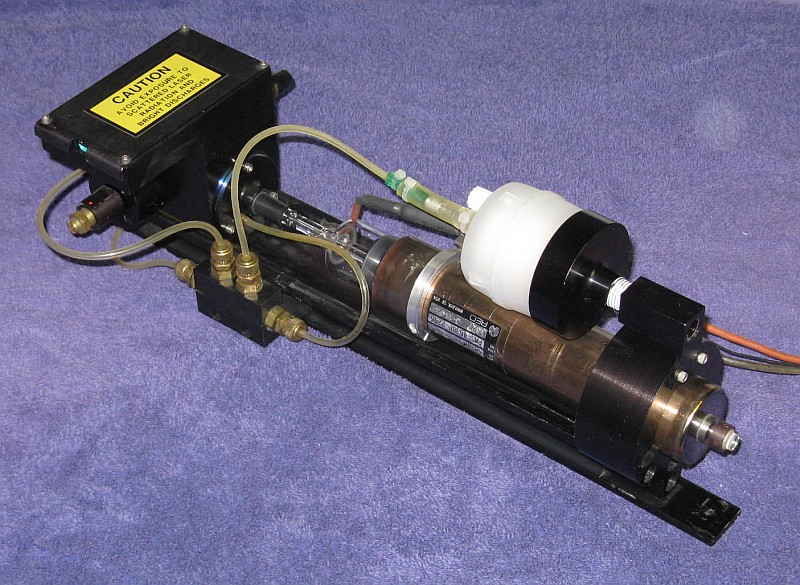
But this one has a one-Brewster He-Ne laser tube with internal and external HRs. (Actually, “LS27″ was on the tube itself; the entire assembly has no number.) I’ve since discovered that on PMS particle counter that uses this or a very similar assembly is the PMS Micro Laser Particle Counter Turbo 110, whatever that it. At least, a photo of the insides of one shows something that looks like this laser!
The particle stream passes through the intracavity beam. An elaborate gas flow system maintains positive pressure of clean filtered gas to prevent contamination of the Brewster surface and external HR mirror by the separate gas stream containing the particles being counted. Having been manufactured in 1996, the 1-B design may pre-date the external resonator design.
The tube is labelled Model: SB/1M, Serial Number: PMS-4638P-2296, and is physically similar to the one described in the section: The Ohmeda Raman Gas Analyzer REO One-Brewster Laser. The glass end of the tube can be seen near the middle of the photo with the Brewster window hidden by a cylindrical dust cover sealed with O-rings that can be pulled back for cleaning. Unlike any of the other PMS/REO lasers (except for the LSTP tunables), this laser also has 3 ceramic magnets glued to the side of the tube, and they do increase the output power by about 5 percent. There are 2 magnets opposite each other near the cathode-end and 1 near the anode-end. The second magnet near the cathode seems superfluous since its effect is minimal but might help a tiny bit. (They may not have put a second magnet near the anode because it would have been dangerously close to the anode connection!)
The power supply is a Voltex brick (which someone had cut all the wires off of, literally 1/4” from the brick. But with wire extensions carefully spliced and insulated, it still works!). The power supply is labelled and set for 5mA for some reason (perhaps for maximum life), compared to the usual 5.25mA or 5.5mA of the other PMS/REO tubes.
With the external HR in place, lasing is mostly on the normal 632.8 nm (red) with a small percentage of several other lines:
Wavelength "Color" Percent
----------------------------------
611.9 nm orange 3%
629.4 nm red 5%
632.8 nm red 80%
635.2 nm red 8%
640.1 nm deep red 4%
For particle counting, only the total intracavity power matters, not the wavelength. Thus, there is no tuning prism in this unit.
The photodetector appears to be identical to the one in the external resonator system (including the safety label), probably using an avalanche photodiode since there is a 200v DC power supply attached to it. A reflector and big fat focusing lens directs flashes from any particles unlucky enough to pass through the intracavity beam into the photodetector. The only other sensor is a photodiode mounted on the tube’s HR mirror, presumably to monitor waste beam power.
As with one of the Ohmeda tubes, this one was also weak at first with an excessively pink slightly dim discharge. But it eventually recovered (though there were a few bumps in the way) with extended run time as the discharge now looks normal (salmon color and bright, possibly near-new and slightly overfilled) and the waste beam power has increased to something very respectable. (See the section: REO One-Brewster Tube – Very Low Output.) So far, the only sick soft-seal tubes that seem to consistently recover to near-new performance with extended run time (as long as there is no contamination from really annoying things like H2 and water vapor) are those from REO. Some other manufacturers’ tubes may improve somewhat, but not to this extent, and others simply get worse.
To determine the actual reflectivity of the mirrors and thus the intracavity power, I subsituted a 60 cm RoC, 99%@633nm mirror for the external HR. Rather than attempt to remove the REO mirror itsefl, I simply unscrewed the mounting plate and substituted an instant adjustable mount of my own. 🙂 By measuring the output power from the OC, and knowing its reflectivity, the intracavity power could be calculated. The ratio of the waste beam power from the internal HR to intracavity power represents the transmission (ignoring losses) of the internal HR or Ti. Then, the transmission of the external HR or Te is just the ratio of external to internal waste beam power times Ti. This all went smoothly with the results shown below:
Power from <------- External Mirror -------> Intracavity
Wavelength Internal HR Type Reflectivity Power Power
-----------------------------------------------------------------------------
632.8 nm 2 uW 60 cm OC 99.0% 1,300 uW 0.13 W
" " 86 uW REO HR 99.9959% 246 uW 6.0 W
" " 165 uW " " " " 472 uW 10.7 W
(The last entry is after the full recovery.)
Based on the 60 cm OC’s measured reflectivity of 99% and the waste beam power from the internal HR of 2 uW with an intracavity power of 0.13 W, it is allowing only 1 part in 65,000 of the intracavity beam to excape for a reflectivity of around 99.99846%, Wow! If the external HR were that good, the intracavity power would be even higher.
The Keuffel and Esser 71-2615 Autocollimating Alignment Laser
(Perhaps this section would be more at home in the chapter: Laser Instruments and Applications. But since it has a vintage HeNe laser and didn’t seem to fit any category there, here it is!)
So someone sent me this “thing”:
The common autocollimator is an optical instrument for measuring extremely small angular deviations using a point light source, collimating telescope, and beamsplitter to enable the reflection of the light source to be viewed from the side on a graticule. A Web search for “autocollimator” should provide hours of bedtime reading on this subject. 🙂
The autocollimating alignment laser uses, well, guess what, a laser for the light source and a pair of split photodiodes in place of a human observer. Such instruments can supposedly measure down to arc-seconds.
The Keuffel and Esser 71-2615 is LARGE (over 20 inches long) and MASSIVE (over 10 pounds). And I thought that Metrologic military HeNe laser made a good hammer! 🙂 It is all precision machined and must have cost a fortune new. The thing is also beautiful, with an exterior that is very nicely chrome plated..
The beam out the front is about 1/2″ in diameter, only a few hundred uW, rated 1 mW max. The connector on the back has 4 pins that test as diodes.
> I did a brief patent search but didn’t find anything relevant. Here is a discussion on the USENET newsgroup sci.optics precipitated by my request for info (loosely based on the description above).
(From: Wade Kelman.)
It’s absolutely worthless, and you should send it to me. I’ll throw it out for you. 🙂
Actually, I think you have an alignment telescope that is accurate to a fraction of an arc-second, much better than the visual kind that use reticles for alignment.
I’m surprised that the K&E – Brunson – Cubic Precision Web site doesn’t have information on this. Or, you could just call them and ask about it.
(From: Adam Norton.)
What you have is an electronic autocollimator used to measure angle deviation of the reflected beam in the arc-second range. Along with tooling mirrors, penta prisms and such, it is used to do optical alignment, check machine tool way flatness & perpendicularity, surface plate flatness, shaft straightness, etc. In crappy used condition these are worth about $1K (check out ebay). If you had (or could make) the readout, you might get much more. Please do not disassemble as that will ruin the alignment.
(From: Sam.)
I wonder if this was an one of those ideas that never really caught on. There are others out there on eBay and elsewhere, but little (easily located) information.
I did find 5 photodiode outputs on the back that respond to reflected light. I couldn’t tell if they were sensitive to slight misalignment though. That would be my next experiment. I wonder what’s needed for the readout? Just some op-amps and meters for X and Y?
(From: Adam Norton.)
I replied to the original post before seeing this branch of the thread. This is definitely an idea that has caught on. Check out the Brunson Instruments Web site (which acquired the Cubic Precision/K&E line). Also look at Davidson Optronics and Moeller-Wedel.
To get a signal from the quadrant detector that is proportional to angle and insensitive to reflectance or beam power you need to use the following formulas: Q1, Q2, Q3, Q4 are the signals from the four quadrants:
X = [(Q1+Q2) - (Q3+Q4)]/(Q1+Q2+Q3+Q4) Y = [(Q1+Q4) - (Q3+Q2)]/(Q1+Q2+Q3+Q4)
Older systems used to do this all with analog amplifiers. On-Track technologies among others sell such amplifiers.
(From: Sam.)
This one uses a pair of split detectors so the denominators of the above equations should only have two terms, but would be otherwise similar.
(From: Phil Hobbs.)
In analog, you can do it right down to the shot noise, which typically means something in the hundreds of picoradians rms. Just needs a mildly modified laser noise canceler. See, for example: Ultra-sensitive laser measurements without tears.
Of course, in real life the accuracy will be limited by stray fringes and QE drift in the diodes, but you really can see very very small angular movements this way.
(From: Sam.)
OK, I know you told me not to disassemble the thing. But I may want to do that since the laser tube is very weak – about 30 microwatts out the front and getting weaker with run-time. So, it’s end-of-life and is unlikely to get better under any conditions. I assume it should be close to 1 mW when new.
If it were just weak but stable, then the sensitivity would be lower but it will still work so it could be left alone. But it’s getting worse. It’s clearly an old laser which really needed to be run periodically to maintain its health and was not. (I even found a pic in an auction for one with a notice to this effect.) That would date it to no later than 1980 or so. Soft seal tubes like that went away by 1980. Well, this has probably sat unused for years, if not decades! (However, it seems the tube must have been replaced around 1986, see below.)
It looks like there are 4 setscrews around the perimeter at several locations that do the alignment and lock the laser in place, though not having seen a diagram, there could be others further forward. Originally, I thought the setscrews were covered with hard Epoxy but it turns out that is just a crust over the top, and poking through it with an awl allows these caps to be popped out. Then, there is only some goopy tar-like stuff, for reasons unknown other than to discourage such tampering! 🙂
If only 2 of the setscrews were removed, the alignment would be maintained, though of course a modern replacement tube – assuming one could be made to fit at all – will also not have the exact alignment of the original. But a jig could be made to adjust it.
Any suggestions other than simply use it or sell it as-is?
It’s not a big deal either way. The only reason I have this at all is curiosity! 🙂
(From: Adam Norton.)
I do not know what this looks like on the inside, but given how stable this thing has to be, I would imagine practically everything would be potted in place inside. If you can replace the laser, trying to align it parallel to the outside housing within a fraction of an arc second might be very tricky. If you can not do that accurately, the gadget still might be useful to measure changes in angle.
(From: Sam.)
That’s my feeling. It was useless they way it was with the power declining toward zero the more it was run.
Fortunately, there is no potting anywhere, though some assemblies were locked in place with some globs of Epoxy.
The setscrews seem to adjust the rear of the laser, the front of the laser, and the beam expander position, which makes sense.
I’ve got the front and rear sections out now.
The front section has the output collimating lens and beamsplitter and photodiode assembly.
The rear section has the laser tube and rear laser mirror. The front laser mirror is still stuck inside. Go figure.
This uses a two-Brewster laser tube with external mirrors. What I haven’t figured out yet is hot to get the remaining section with the front laser mirror and expanding lens out. It’s about as inaccessible as possible, more than 10 inches in from either end, and doesn’t seem to want to move, though I may just need a bigger pry bar. 🙂
I’ve also removed the diverging lens and spatial filter assembly.
Unfortunately, so far I have been unable to remove the final remaining piece which holds this as aligns it with the HeNe laser. This also retained the output mirror and mount from the HeNe laser.
Nothing has been damaged so far so it should go back together.
I’ll have to replace the laser tube with a modern internal mirror linearly polarized laser tube and arrange to mount it in a similar way. The polarization is needed to optimally separate the outgoing and return beams via a polarizing beamsplitter and Quarter-Wave Plate (QWP).
BTW, the date on the laser tube is 1986. My guess is that it was replaced in 1986 and they used an original design tube, since by then, internal mirror polarized HeNe lasers were widely available and a lot cheaper and less finicky than this contraption. (It was almost recent enough that a red diode laser could have been used but probably not quite.)
It’s a custom Hughes two-Brewster HeNe laser tube, a model 3183M. This is short, about 8 inches from tip to tip. Perhaps “M” stands for modified? The mirrors are in massive stainless steel mounts and 1/2″ or more in diameter mirrors – unusually large for such a laser. Why? The Radius of Curvatures (RoCs) are 30 cm for the OC and planar for the HR.
I was able to remove the mirror mount deep inside the big cylinder with a hex driver extended with 3/8″ copper pipe. 🙂 What was left inside – the mounting plate for the spatial filter/beam expander, electrical connector for the photodiodes, and the OC-end of the HeNe laser – finally yielded to a scrap HeNe cylinder pounded by a 5 pound hammer. 🙂 There appears to be some glue residue that was holding it in place, perhaps the last defense against revealing its secrets. Being able to lay out the parts on the bench will make it a lot easier to realign.
Using a Melles Griot 05-LHP-605 laser head with just the front end-cap removed, it was quite straightforward to install and align the expanding lens and spatial filter to the axis of the main cylinder. The inside diameter of the 05-LHP-605 cylinder is about the same as that of the original laser, so it is a snug fit to the mounting plate at the front. The expanding lens was screwed to the mounting plate snug enough that it would not move on its own, but could be pushed around with the 4 setscrews around the perimeter of the mounting plate. The laser and mounting plate were slid into the main cylinder and then the beam was aligned with its optical axis using the setscrews. After pulling it back out, the spatial filter could be screwed in place and adjusted to cleanly pass the beam. With the 05-LHP-605, the output beam is only about 7 mm in diameter – around half of that with the original laser.
So, I need to find a short polarized HeNe laser tube with a wide beam. A standard cylinder diameter will fit. The trick will be matching the beam diameter so that the expander works correctly and results in a large diameter final beam. I suspect the Hughes has a rather wide beam diameter and possibly a wide divergence as well with its 30 cm RoC OC and planar HR. That is similar to what the gold-cylinder Hughes lasers use. But it may be tough to test since it’s so near dead that getting it lasing would be a major issue. Since the axial position of the collimating lens is slightly adjustable, the divergence won’t be a big issue. But the laser beam diameter will be proportional to the final beam diameter, and finding a modern tube with sufficiently wide beam may prove challenging.
The Melles Griot 05-LHP-605 I used for testing, about 1 mW, could work. But the divergence and beam diameter result in a final beam that is too narrow for the collimating lens of the autocollimator (about half the original). This would probably be acceptable but not optimal. Matching this may be the hardest part of this retrofit.
A suitable normal tube might be the 05-LHP-410 which has a relatively wide beam (0.85 mm). But I’ve never seen one of those.
Linearly polarized barcode scanner HeNe laser tubes may also be suitable Possibilities include the 05-LHP-004 and 05-LHP-690 but their beams are closer to 0.5 mm so the final beam diameter wouldn’t be much better. But polarized barcode scanner tubes aren’t common.
An alternative could be a diode laser. But matching the beam quality of any HeNe would be a challenge.
Far East HeNe Laser Tubes 1
These are from a Chinese company called Artworldcn Enterprise Limited. Navigating this Web site is shall we say, challenging, so here’s a direct link to Artworldcn’s HeNe Laser Product Page, which has some basic specifications. (There used to be a jumbled mess at the bottom of that page supposed to be an ASCII diagram of an early RF-excited HeNe laser and was copied directly out of this chapter of Sam’s Laser FAQ! But they neglected to also copy the HTML formatting specifying a fixed-width font, so it was totally unrecognizable (except to me! If you’re at all curious, check out the diagram in the section: Early Versus Modern HeNe Lasers.)
The chart on that Web page includes the following information:
Cavity Total Tube Working Trigger Working Output Diver- Model Length Length Diameter Current Voltage Voltage Power gence ------------------------------------------------------------------------------- 150 140 mm* 150 mm* 28 mm 3 mA 4 kV 1.3 kV 0.8 mW 180 180 mm 190 mm 28 mm 4 mA 4 kV 1.4 kV 1.2 mW 200 200 mm 210 mm 30 mm 4 mA 5 kV 1.5 kV 1.4 mW 230 230 mm 240 mm 35 mm 4 mA 5 kV 1.5 kV 1.5 mW 1.25 mR* 250 250 mm 260 mm 36 mm 4 mA 5 kV 1.5 kV 2 mW 280 280 mm 290 mm 36 mm 5 mA 5 kV 1.5 kV 3 mW 300 295 mm* 305 mm* 36 mm 5 mA 5 kV 1.5 kV 5 mW 3 mR* 320 320 mm 320 mm 36 mm 5 mA 5 kV 1.5 kV 5 mW 350 350 mm 360 mm 36 mm 5 mA 5 kV 1.5 kV 7 mW 400 400 mm 410 mm 36 mm 5 mA 5 kV 1.5 kV 8 mW 450 450 mm 460 mm 39 mm 5 mA 5 kV 1.5 kV 10 mW 480 480 mm 490 mm 39 mm 5 mA 5 kV 1.5 kV 12 mW
(The voltage specs for all these tubes are rather suspect since the values don’t change much with output power and I haven’t measured them even for the tubes I’ve tested. Values denoted with “*” were measured; all others from their Web site. This doesn’t mean they are accurate, just that I haven’t measured them.)
Model 150: The first tube I tested was the model 150 (150 mm, ~6 inch tube), similar in performance to a common barcode scanner tube. The construction of this (as well as the others) is, well, strange as shown below:
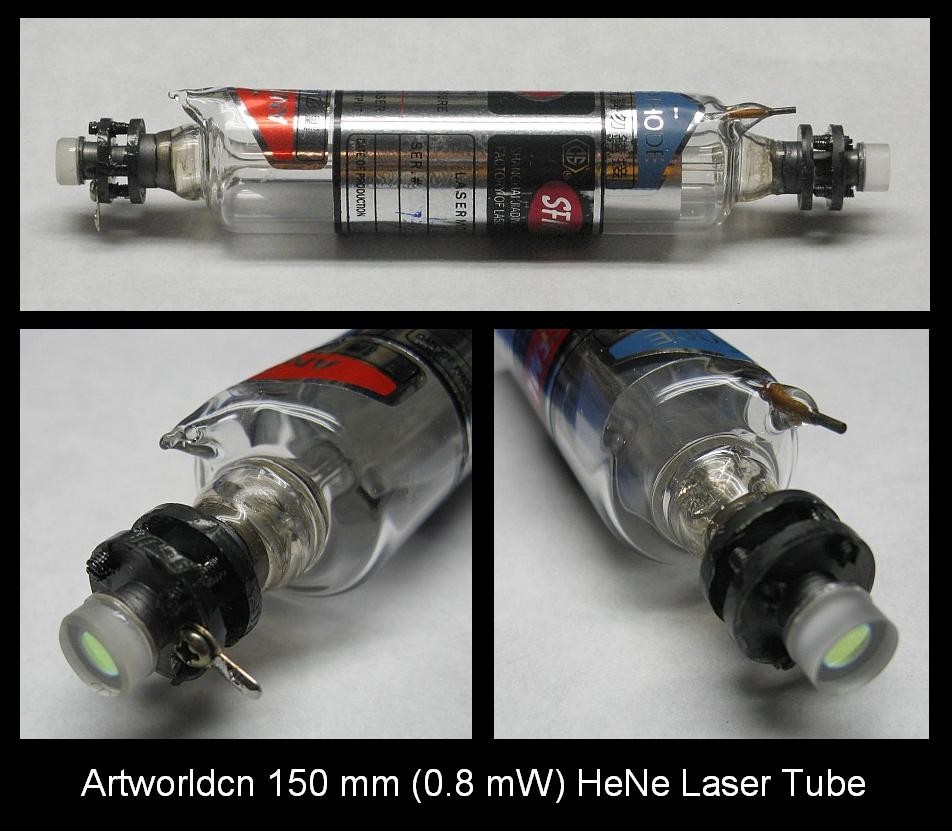
As can be seen, the actual tubes they are shipping bear little resemblance to what’s on their Web site. The entire tube is made of glass except for the mini-adjustable mirror mounts, which are similar to those used in Hughes-style tubes except that they have 4 slotted-head screws instead of 3 hex-head screws. Who uses slotted head screws in precision devices any more? And at least one screw head was already broken! The mirror substrates appear to be attached via a thin layer of glass frit, not the bead that’s present on virtually all “normal” tubes. Only the anode uses the mirror mount for the electrical connection; the cathode (which is a normal aluminium cylinder, partially hidden behind the label) has its own terminal via a glass-to-metal feed-through. And to make sure people don’t do something stupid, the cathode mirror mount normally has heat shrink over it to prevent its use as the negative electrical connection (removed for the photos). Electrically, the tube behaves normally and should run on a typical He-Ne laser power supply for 0.5 to 1 mW lasers. The specs call for 3mA at 1.3 kV with a 4 kV start.
The output by eye at least is close to TEM00 with a very low M-Squared. So, as a pointer, alignment laser, or barcode scanner, it would be fine. Using a diffraction grating, the only wavelength present appears to be 632.8 nm (at least in the visible). That’s the good news, and without actually making measurements, it appears like any other HeNe laser tube of similar size and output power. However, with respect to modes and polarization, this is about the most cantankerous small HeNe laser I’ve ever seen.
The first thing I noticed after admiring the most artistic (some would say primitive) glass work 🙂 was that there is no AR coating on the OC mirror, none, not even a puny attempt at an AR coating. I’ve never heard of any production HeNe laser lacking an AR coating on its OC. Even the 45 year old Spectra-Physics 115 laser had one! Second, as evidenced by the absense of any ghost beams, neither mirror substrate is wedged. So, there will be back-reflections from the outer surfaces of both mirror substrates directly into the laser cavity. I fully expected these back-reflections to make a mess of the tube behavior, and indeed they do. But I was not expecting it to be nearly as strange as reality, or reality to be so strange. 😉
Using a polarizer with a PC data acquisition system from a cold start to almost 30 minutes, the behaviour is extremely bizarre. See:
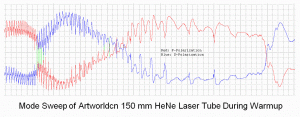
. This was taken after optimizing alignment (see below) so the total range of the vertical axis is approximately 1 mW. Virtually all common He-Ne laser tubes of this length (about 150 mm) go through a predictable mode sweep with two orthogonal polarizations (here called S and P) alternating as the tube expands and the longitudinal modes drift through the neon gain curve. Compare this to plots for a typical tube of similar size and output power in
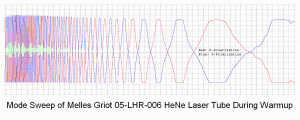
. Adjacent modes are orthogonally polarized and the power in each mode goes to exactly zero for a portion of the mode sweep cycle in such a short tube. Even those tubes that are “flippers” generally produce a repeatable pattern, although it might change from flip to non-flip behaviour at some point during warmup. But this tube tends to favour one polarization for a few minutes mode sweeping within it alone except for some random burps of the other polarization, and then slowly shifting over to where the other polarization dominates. Within each of these extended temporal regions, one polarization has the most power with occasional dips, while the orthogonal polarization only shows low level twitching and bumps. So it behaves like a poorly polarized tube for awhile (many mode sweep cycles) and then the polarization changes. A few flips can be seen (vertical green lines) but for the most part, the modes change smoothly, so it is not strictly speaking, a flipper. However, even though the total power output doesn’t vary that much, it does so in such a way that there is a noticeable discrepancy in the shape of the plots of the P and S polarized modes, especially over a short time period. With normal tubes, they are virtually mirror images of each-other. Yet another very unusual characteristic of this tube.
On a Scanning Fabry-Perot Interferometer (SFPI) the behavior is even more striking. It was necessary to add an ND1 filter to minimize back-reflections from the SFPI before the display settled down, but that’s not unusual, and this could also be largely avoided by positioning the SFPI far away from the laser and aligning it slightly off-center. At first, with no polarizer, the display appeared as though it could pass for a normal tube, with the modes happily drifting through the neon gain curve. I wouldn’t have given the display on the SFPI a second glance if this were a common tube. But knowing that there was already something very peculiar about this tube, using the polarizer oriented to pass the most power, the display was essentially unchanged from what it looked like with no polarizer – for awhile. Only linearly polarized He-Ne lasers behave like that. But then the modes gradually disappeared and it was necessary to reorient the polarizer to get back a similar display. I’ve have never seen this type of behaviour in literally hundreds of He-Ne lasers tubes I’ve tested.
As a test, I put a drop of alcohol first on the HR and then on the OC mirrors. There was little effect with the HR, but the output power in one polarized mode instantly increased dramatically when done on the OC. This was too fast to be a thermal effect, so perhaps an AR coating alone would be enough to make the tube behave. However, while my quick alcohol drop test showed that something changed, it was not clear if behavior was actually significantly improved. And, putting a glass plate at a very slight angle against the OC with some water to index match didn’t seem to help, so it’s quite possible that other more fundamental modifications would be required.
This sample was also originally annoyingly weak (about 0.4 mW, well below spec) and that of course presented an irresistible challenge. However, it turned out to be rather easy to realign the OC mirror (cathode-end) by adjusting those antique slotted-head screws to boost the power output to over 1 mW. But just when I thought the situation couldn’t get any worse, as a result of the optimization, a rogue mode appeared on the SFPI which wasn’t there before! (And to confirm that I hadn’t simply missed something, misaligning the mirrors makes them disappear, perhaps that’s why it was adjusted to be so weak!) The rogue mode can be seen during part of what passes for a mode sweep cycle on this tube as shown in
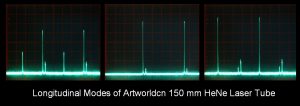
. The Free Spectral Range (FSR) of this SFPI is 2 GHz. The longitudinal mode spacing of this tube is about 1.034 GHz based on a measured mirror spacing of 14.5 cm. I believe the two tallest peaks on the left photo correspond to the normal (expected) TEM00 modes. Based on the 2 GHz FSR of the SFPI, the tallest and next tallest to the right of it would be just about 1.034 GHz apart. The rogue mode is to the right of one of the main modes, usually but not always the largest one, about 125 MHz higher in frequency than the mode it’s hugging (based on the direction of drift of the peaks on the display during mode sweep). At first I thought it was a longitudinal mode. A measurement of the beat frequencies, if any, would prove conclusively that the mode is indeed adjacent, and not aliased as a result of to the 2 GHz FSR of the SFPI (due, for example, to some other lasing line that’s not supposed to be there, perhaps IR). And with a Thorlabs DET210 detector (1 GHz bandwidth), there could be no doubt: A beat of around 125 MHz was indeed present for a portion of the time, coming and going as expected. A rogue longitudinal mode would seem to be essentially impossible as there is no way for there to be any reflections inside the cavity at a shorter distance than the mirrors. It would have to be approximately 15.6 mm closer based on the 125 MHz difference. So, could it be a higher order spatial mode? This would seem to be the most likely explanation. And it gets even weirder. Looking closely at the SFPI plots, the rogue mode turns out to actually be a pair of modes, confirmed by their beat frequency to be about 15 MHz apart! At first everything appeared totally perplexing, but assuming these are higher order spatial modes not visible even by careful inspection of the beam profile, it begins to make sense, as they would totally scramble the SFPI display, which generally assumes a TEM00 beam.
As an aside, the cavity geometry of this tube is backwards from nearly all others: The OC is planar and the HR is curved with a RoC measured to be unbelievably long at around 1 meter based on reflecting a parallel beam from outside. With that RoC, Matlab produces a frequency offsets for the first higher order spatial mode that is close to 125 MHz. The fact that it’s split could perhaps be due to some asymmetry in alignment.
The main reason that multi-spatial mode operation was the first thing to suspect was the nearly perfect the beam profile. In fact, it may even look better than a more normal short barcode scanner tube. Now in all fairness to Artworldcd, their Web site does say: “Wavelength 632.8nm multi made,long operating time warranty time 1year”. OK, so perhaps they need an English translator in addition to some tube redesign. 🙂
Here’s a summary of observations and peculiarities:
- There is no AR coating on either mirror.
- There is no wedge on either mirror substrate. This was determined by lack of ghost beams.
- The OC is planar and the HR is curved, around 1 m RoC based on how it expands a parallel beam reflecting from the outside.
- The beam is a very nice Gaussian TEM00 by eye at least at 20+ feet. However, there are probably higher order spatial modes present at times.
- The wavelength appears to be only 632.8 nm (except for the multiple modes of various types). There are no other visible wavelengths detectable using a diffraction grating. I doubt any IR lasing wavelengths to be present with such a short tube.
- The output tends to favor one polarization for awhile, then slowly switches to the orthogonal polarization.
- Within each region, the longitudinal mode amplitude fluctuates in a quasi-periodic manner with bumps probably corresponding to the normal mode sweep power variation.
- There are short term variations in total power so that the amplitude of the two orthogonal polarized modes are not mirror images of each-other.
- Index-matching to the external surface of the OC mirror to minimize reflections has some effect but doesn’t make tube behave. Index-matching to the outer surface of the HR mirror has little or no effect.
- On the SFPI, a rogue mode can be seen approximately 125 MHz higher in frequency than the normal longitudinal mode it is near. This separation has been confirmed with a fast photodiode by observing the beat frequency on an oscilloscope. It is assumed that this is a higher order spatial mode confusing the SFPI.
- The rogue mode is actually a split mode, found by careful inspection of the SFPI display. The separation of the pair has been determined to be around 15 MHz by measuring the distance between null points of the 125 MHz signal envelope. Using my high resolution SFPI, there are also hints of additional small modes very close to the large ones, all assumed to be higher order spatial modes.
Thus, aside from the multitude of unknowns, everything is obvious. 😉
I’ve since tested 2 other samples of this same model tube. The serial numbers of two of them are 746 and 1,375, acquired from the company within the last month (April, 2011), so these were likely current production. The third one had no SN label. Even assuming they started at SN1, at most 1,375 had been built to date. Each of the three have unique personalities but generally similar overall behavior. The second tends to remain much more polarized before swapping polarizations while the third produces spikes of the opposite polarization that are fairly regular until it switches polarization and then does the opposite. SNs 746 and 1,375 both had similar higher order spatial modes displayed on the SFPI, while the unmarked tube appeared to be pure TEM00. However that tube was running at slightly lower output power (0.8 versus 1 mW). The alignment screws were too well sealed to attempt to boost it, where higher order spatial modes would be more likely. There are no obvious physical differences but a slightly narrower bore can’t be ruled out.
Some aspects of the glass-work are rather crude. For example, the orientation of the tip-off with respect to the cathode terminal differs on all three. And the bore end inside near the cathode-end of the tube has probably been cut by scoring and snapping, not with a diamond saw as there are obvious chunks missing on some places.
So, as noted, using a tube like this for pointing or alignment or anything else that depends solely on the appearance of the beam should be fine. And, I’ve been told that it isn’t too bad for demonstrating the basic principles of a Michelson interferometer. But anyone hoping to build a stabilized HeNe laser or do serious interferometry or holography – or even to explain what longitudinal modes are all about in a classroom – could end up totally frustrated.
But this is a cute little tube! It’s possible that only minor modifications would be required to eliminate all these deficiencies, starting with the use of wedged substrates for both mirrors and AR coating of the OC mirror. Using a slightly narrower bore possibly in conjunction with a different RoC for the HR mirror would suppress the higher order spatial modes. (A mirror with that large an RoC is probably the same one they use for their other longer He-Ne laser tubes. They then control the reflectivity with the planar OC.) But why not simply copy the relevant parameters from a common 6 inch barcode scanner tube? All of these changes should have only a modest impact on manufacturing cost. Then the tube would not only be cute, but might actually work well and be rather boring like all the others. 😉
From what I’ve determined, these tubes are less than half the price of those of similar output power and size from companies like Melles Griot or JDS Uniphase. So there should be some room for well justified added cost while still being much less expensive than the others.
I’ve since done tests of two other higher power tubes as shown below:
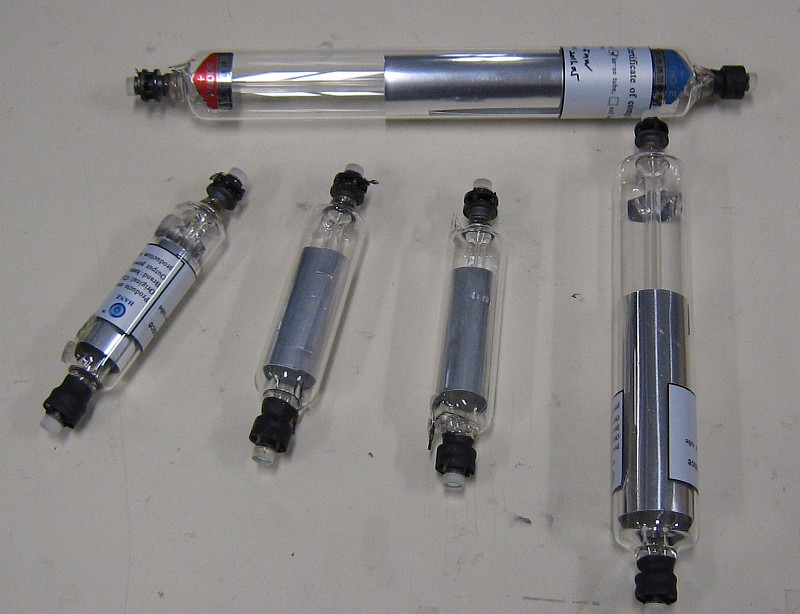
The results were totally unremarkable. 🙂 The longer tubes in the photo are rated 1.5 mW and 5 mW.
Model 230: As with the model 150, there is no AR coating on the OC. The output is a nice low divergence beam which appears to be pure TEM00 with a measured output power after a brief warm-up of 2.4 mW. Other than some instability when two modes approach equal amplitude, the mode sweep behaviour was textbook in nature with no evidence of higher order spatial modes. In the instability region, the modes would bounce up and down, with a possible mode flip. This sort of behaviour is not unusual even in some high quality He-Ne laser tubes, though it is generally not present with most.
Model 300:
Again, no AR coatings. This one is highly multimode (not TEM00) which explains its relatively short length compared to common 5 mW (rated) tubes from other manufacturers. The output power after warmup is over 6.25 mW in an interesting beam. 🙂
Bendix JL-1 RF-Excited HeNe Laser
This one is truly ancient, certainly before 1965, perhaps much earlier. It was probably one of the first educational lasers ever sold. The laser head is covered in amber Plexiglas with the plasma tube clearly visible. The wavelength was probably common 633 nm red with an output power of 1 or 2 mW at most. It has huge bulbs holding the Brewster windows, possibly “repurposed” chemistry lab-wear based on the printing visible on them. There is an impedance matching coil inside the case with an RF connector on the back side. Regrettably, I have not seen the RF exciter. While one would assume that the tube is up to air after almost 50 years, this may not be the case. It is hard-sealed – no Epoxy anywhere. The glass is thin, no getter, no metal inside tube at all, nothing passes through its wall. So, while it may not lase due to He depletion either from use (RF tends to suck He out of thin-walled tubes) or from age, it may still be gas intact and retained its Ne. In that case, a He soak for 6 or 7 weeks (1 day for every year of age) should restore it to like-new condition. 🙂 Stay tuned.
Here are some photos (coming soon):
-

Overall back of Bendix JK-1 Showing RF connector and warning labels -
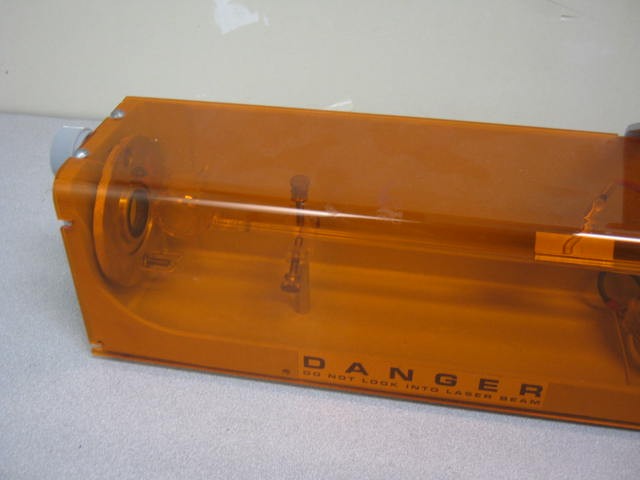
Closeup of Bendix JL-1 HR-End Showing Mirror with Adjustment Knob -
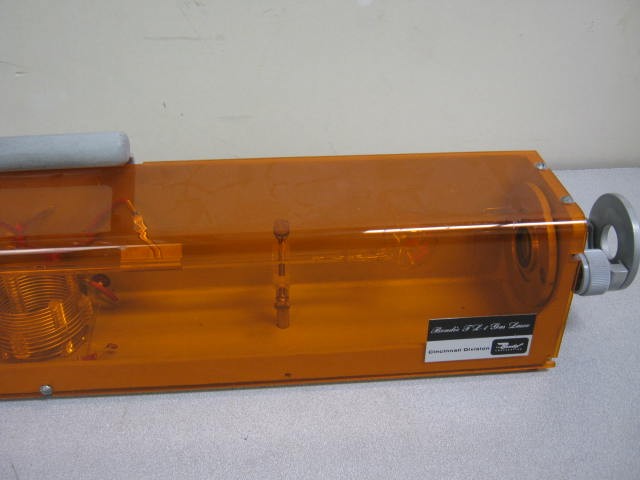
Closeup of Bendix JL-1 OC-End Showing Mirror with Adjustment Knob and Optics Holder View 1 -
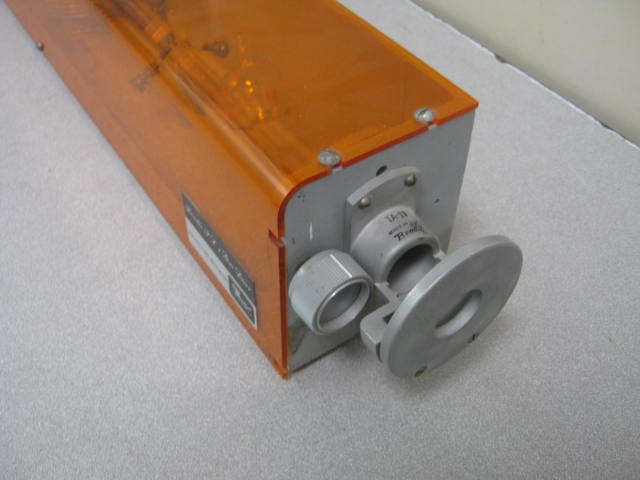
Closeup of Bendix JL-1 OC-End Showing Mirror with Adjustment Knob and Optics Holder View 2
Melles Griot Dual Output Green He-Ne Laser Tube
This is probably another “oops”. 🙂 It’s supposed to be a Melles Griot 05-LGR-024, a short green (543.5 nm) tube with a spec’d output of 0.2 mW and TEM00 beam profile. However, someone at the Melles Griot factory must have been smoke’n sump’n that day and stuck OC mirrors on both ends. So, it actually produces 0.3 to 0.4 mW from each end and the beam profiles are multi-spatial mode, something along the lines of TEM11. (The total output power is much higher than the spec because it is a new tube and probably since it is multimode.) Optically, the mirrors are the same, both nearly planar by eye, but actually behaving concave using an external red laser reflected from them, which results in a focus at 3 or 4 meters. My assumption is that they actually have a normal positive Radius of Curvature (RoC) internally but it is masked by a curved outer surface, which is AR-coated and difficult to see let alone actually measure. With two curved mirrors, the intra-cavity mode volume would be incorrect thus resulting in multiple spatial modes. The mirror coatings have virtually the same reflectivity at 543.5 nm, but at 633 nm, the OC is around 6 percent while the HR is around 21 percent. This of course makes no difference for a green laser, but does support the hypothesis that they are from different batches. Thus, it probably wasn’t entirely the fault of the assembler. More likely, there were a few OCs accidentally mixed in the the box labeled “Green HRs”. (I know that at least 3 of these tubes were manufactured.)
Russian (USSR) OKG-13 He-Ne Laser Head
This one is either really ancient, or Russian technology was backward for far longer than could be imagined. The OKG-13 is a HeNe laser head containing a two-Brewster plasma tube with heated filament/cathode and huge (~30 mm diameter) external mirrors. The casing bears some similarity to that of the much larger and very ancient Perkin Elmer HeNe lasers.
Here is a rough translation of the general specifications for the OKG-13:
- Emission wavelength: 0.6328 MKM (0.633 micron, 633 nm).
- Distance between the mirrors: 220 mm.
- Output power: 0,5 mW,
- Anode Voltage: 1.2 +/-0.3 kV.
- Filament voltage: 9 +/-0.5 V.
- Ignition voltage discharge: 5.5 kV.
- Operating current discharge: 5 +/-0.15 mA.
- Dimensions of the generator: 261 x 46 x 51 mm.
- Diameter beam on mirror: 1.3 mm.
And a similarly rough translation of the description:
“The device OKG-13 is a generator of continuous coherent radiation in the visible part of the spectrum and is designed for use in automatic control systems along the line of for precision optical measurements.”
The tube itself appears to be of coaxial construction, with the single filament off to one side, but it is not a side-arm tube. The Brewster windows are attached to rather large bulbs at each end but the bore itself is narrow like that of a modern HeNe laser. The use of a heated filament/cathode went out of fashion 🙂 for most USA HeNes in the late 1960s, though some legacy designs may have persisted into the early 1970s. I have yet to find anything on this laser head assembly that would provide an indication of the manufacturing date. There may be one on the actual glass tube but for reasons that will become clear, I have no current plans to remove it even for inspection or photos. The only label attached to the exterior has the OKG-13 model and a stamped serial number, but no date or date code.
I acquired this laser head on eBay of course, shipped all the way from the Ukraine. 🙂 Here are some photos from the auction (courtesy of Electronics Parts Choice maintained by eBay seller ID: zorolan). These show the laser head in the condition it was received:
-
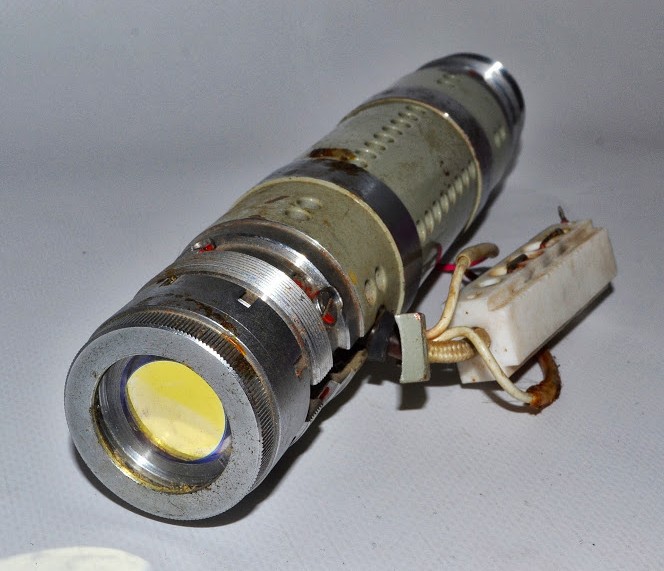
Back View of OKG-13 He-Ne Laser Head Above shows the HR-end with the huge mirror secured by a locking ring. This is normally prevented from turning with a small screw, but once removed, the locking ring is easily unscrewed to remove the mirror and access the Brewster window. The ballast block visible on the right attached to the fat white anode wire contains three 20K ohm power resistors. The two thinner white wires are for the filament/cathode.
-
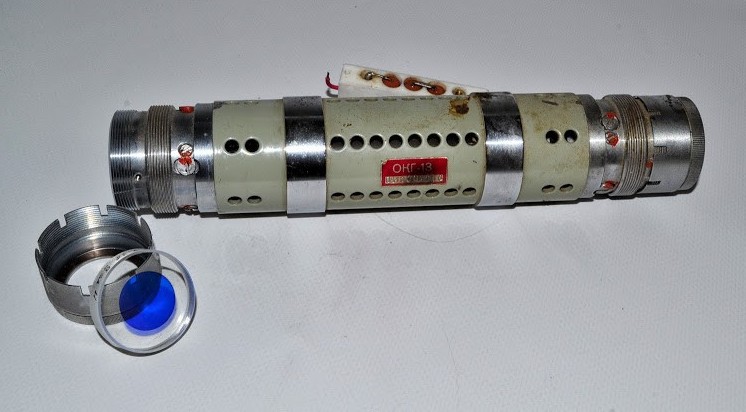
Left Side View of OKG-13 He-Ne Laser Head Above shows the laser head with the OC mirror removed. The huge size of the mirror glass and coating seems a bit excessive since the intra-cavity beam has a diameter of less then 1.5 mm. The The ballast block with can be seen behind the head. Alignment appears is done by adjusting the centering of the tube at the front and back using two sets of 4 headless screws that push on it from the side, seen locked down with red adhesive. (There are also two sets of 4 larger screws that appear to serve no purpose other than filling 8 holes. They may have been originally intended to lock the adjustment screws in position but their heads are too small for that.) The red label says “OKG-13” with a serial number stamped below it. There is no other information on the outside of the head, though some lettering can be seen through the holes on the glass tube itself.
-
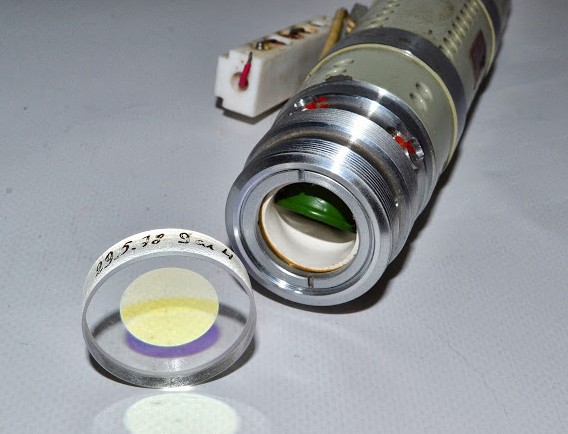
Brewster Window and OC Mirror of OKG-13 He-Ne Laser Head Above shows the huge angled glass plate attached with green Epoxy (or the Russian equivalent). There is some sort of boot made of a soft white material surrounding the window assembly.
When 9 V was applied to the filament leads, the filament immediately lit up nice bright orange indicating that the tube was at least not up to air. Using a variable He-Ne laser power supply, it was easy to initiate a discharge but the color was (not unexpectedly) sickly pink/blue. And at first, I was not optimistic about the chances for a miraculous recovery. However, within a few minutes, there was a very obvious improvement. And within less than an hour, the discharge looked relatively normal with a bright salmon complexion. And even though the OC mirror is in rather poor condition with numerous scratches, careful cleaning of the Brewster window at that end of the head resulted in weak lasing. Initially between 25 and 50 µW. (Since these may be soft-coated mirrors, there may be no practical way to clean them.) I did not remove the mirror at the HR-end because it did not appear to have ever been disturbed. The OC mirror had been removed for the auction photos – I would not prop up a mirror like that up intentionally!
Of course, a dirty laser would never be happy, so it got a nice scrub and massage! Paint touchup and detailing will come later. 😉
-
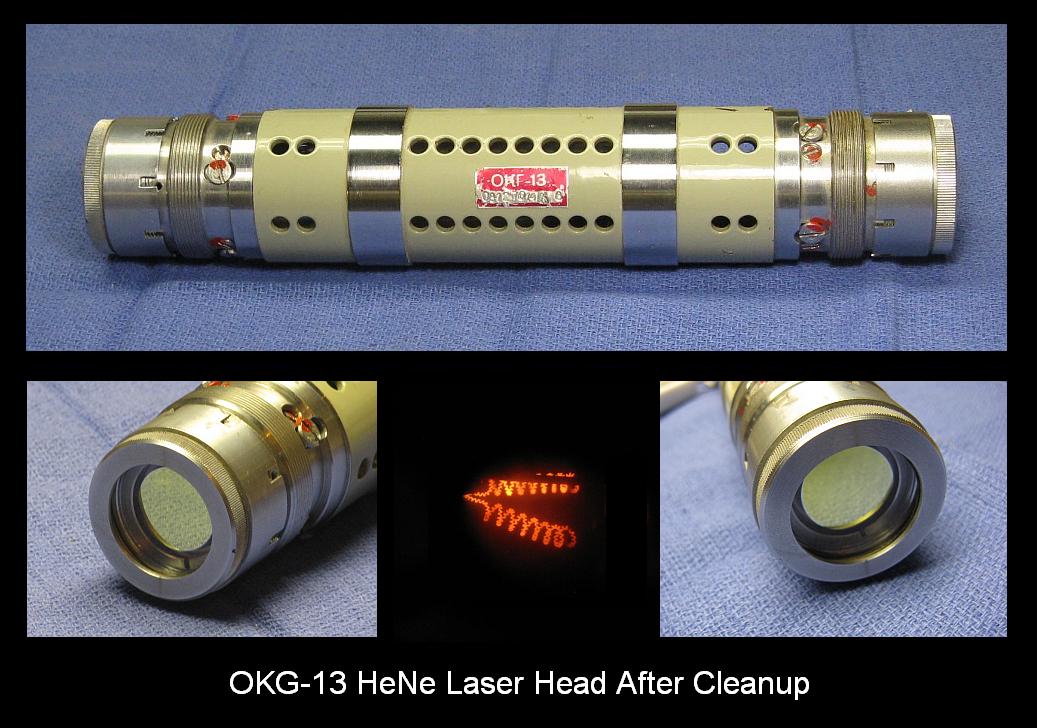
OKG-13 He-Ne Laser Head After Cleanup Above shows the side and end views, as well as a closeup through one of the ventilation holes of the doubly-coiled filament powered with no discharge present (which would obscure it).
It was obvious that much more power was possible as the power nearly doubled when run at 6 mA rather than the spec’d 5mA current.
After several hours, the output power has increased to a peak of over 250 µW at 5 mA, but with a 15 percent mode sweep variation. A maximum power of 340 µW could be reached at around 8 mA.
I’m thinking of building a power supply with a fail-safe circuit preventing the HV from being applied unless there is filament current. The tube would light and lase on a modern power supply without the filament being hot, but that would probably destroy the tube rather quickly from sputtering. In the meantime, it’s using my He-Ne laser power supply protection widget simply to monitor the filament voltage directly from the tube’s filament leads. This will instantly shut off the He-Ne laser power supply if the filament voltage either increases significntly or goes away entirely.
Since a proper cleaning of the OC-end Brewster window was never performed, it seemed like a perfect excuse to remove the OC mirror and test the laser with an external mirror.
Using a randomly selected external mirror that was laying around (45 cm, 98.5%), it was possible to get over 0.53 mW easily. Thus, the plasma tube is still in at least decent, if not very healthy condition. Cleaning of the window could now be done while lasing using a generic grocery paper towel :), acetone, and cotton swabs. In fact, the window was already quite clean and the power only increased perhaps 5 percent.
But when the original mirror was replaced, the output power had increased to almost 0.4 mW! I don’t think this was due to the Brewster cleaning but simply the luck of the draw on the orientation and position of the mirror. The Russian mirror may simply be too far gone to either achieve optimal output power or consistent results. It is extremely sensitive as to position in the holder. (More so than can simply be accounted for by the associated change in alignment.) The coating quality may also be inferior. If I knew it was hard-coated, proper cleaning might help. But attempting to clean a soft-coated mirror with almost anything will damage or destroy it. Unfortunately, no modern mirror would fit without looking like it had been replaced.
By fiddling with the mirror and tube alignment via the centering screws, it’s now possible to get 0.35-0.4 mW sustained, with it actually peaking at almost 0.45 mW when warming up.
-
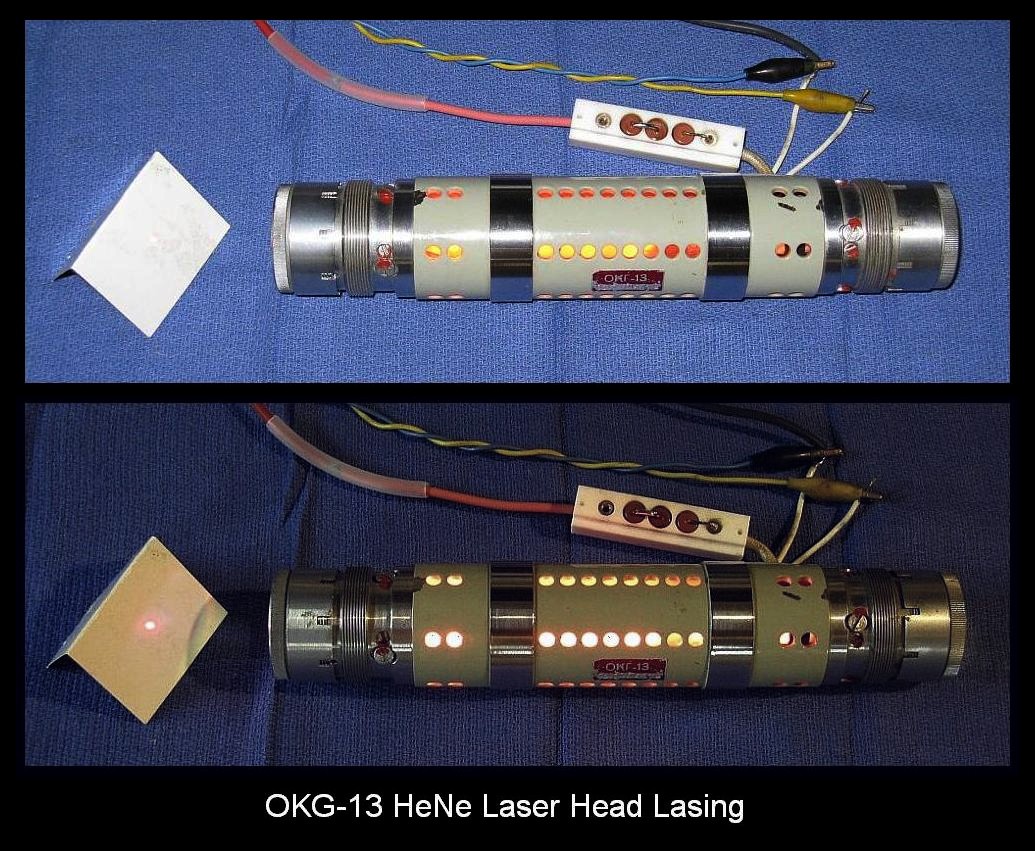
OKG-13 He-Ne Laser Head Lasing Above shows the laser spewing forth coherent 633 nm photons in normal and subdued lighting. It is running on a Melles Griot 05-LPM-379 He-Ne laser power supply using the original 60K ohm ballast. A separate supply provides the 9v DC for the filament. Since the OKG-13 came from almost the other side of the World, I figure it’s acceptable to have the beam pointing to the left, violating my usual rule for laser head direction. 😉 (The real reason is so the label would be right-side-up.)
However, running it any more may be counterproductive. It’s not known what the life expectancy is of a tube like this. It may be as low as a hundred hours or more likely, several thousand. But not the 10K or 20K hours of a modern tube. The power had declined by a couple percent without doing anything. It’s not clear if that’s a tube life problem, or simply alignment changing slightly due to thermal cycling. Although the pieces seem to be locked tightly together, torquing the mirror locking ring does affect the power slightly.
The person who sold me the OKG-13 laser (eBay seller ID: zorolan) was kind enough to send me a scan of the operation manual. But unfortunately, it is – no surprise – in Russian. 🙁 🙂 From what I can deduce looking at the specifications, a photo of the laser head and power supply, and a diagram of the internal construction of the laser head, it’s for a slightly newer model as that diagram lacks any reference to connections for the heated filament. See below:
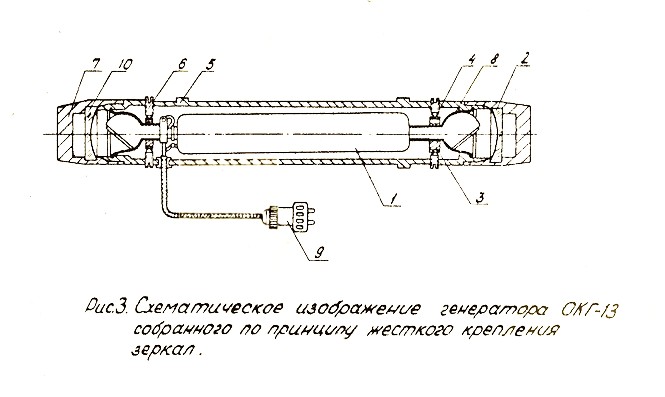
(The curvature of the mirrors is greatly exaggerated and some other details do not match my laser head either, but it’s better than nothing.) And there may be a date (for the manual at least) in there – 1979 – but that’s quite questionable as some of the other date listings don’t make sense. That peculiar value of “0,6328 mkilometre” for the wavelength appears to have originated as “0,6328 mkm” in the manual. Perhaps mkm could be interpreted as a “thousand-thousandth” of a meter (1 micron) rather than a thousandth of a kilometer (1 meter). 🙂 Google does find a few papers that reference the OKG-13 (and other OKG) He-Ne lasers. One has a publication date of 1975 suggesting that the OKG-13 is likely from much earlier. But the others are much more recent suggesting that the OKG lasers may be or may have been very common. Unfortunately, I am unable to access the full text of these papers (probably also in Russian anyhow!).
If anyone is even moderately fluent in technical Russian and willing to do at last a partial translation of the manual, please contact me via the Sci.Electronics.Repair FAQ Email Links Page.
Russian Two-Brewster HeNe Laser Plasma Tube
This tube is also from Russia (I assume the USSR, though I don’t know that for sure). It too has a hot cathode/filament, but it is somewhat longer than the tube in the OKG13, above – about 10.5 inches tip-tip. See below:
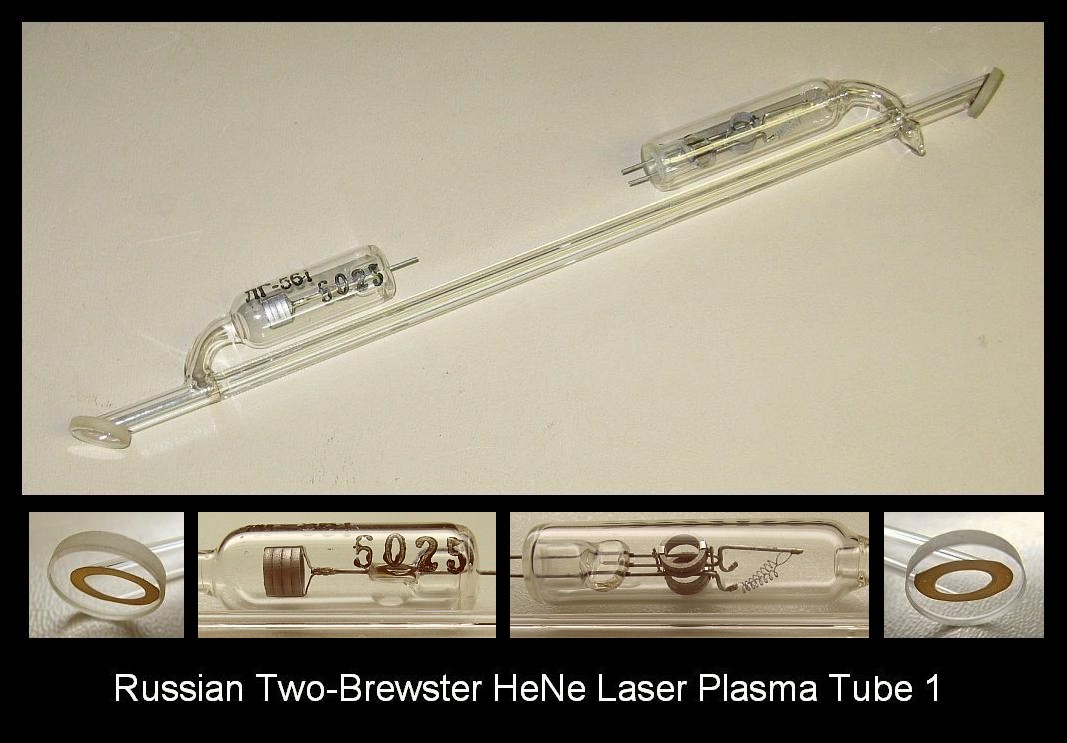
The anode is on the left, though for some reason, it’s not a simple wire electrode as in most other tubes of this type. The cathode/filament is on the right along with a pair of getters. It is not known if the getters have not ever been fired, or are simply exhausted but only leaving a clear residue. This sample appears to be brand new, but it has leaked so a refill would be required to make it work. Just add gas. 😉
The for which this tube is intended uses a three-bar resonator that mounts inside an oversize cylinder as shown below:
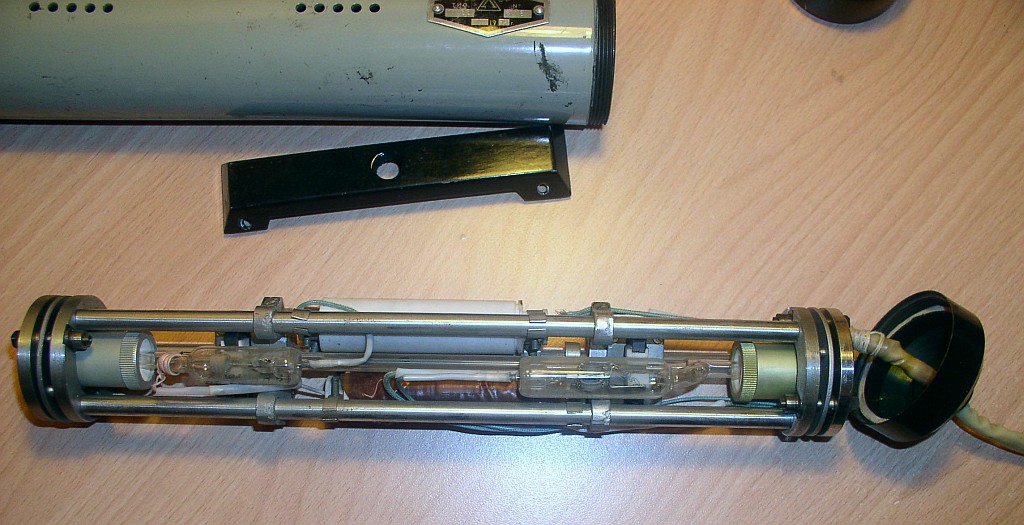
The resonator assembly appears to simply slip inside secured by screw caps at each end. Nothing else is known about the laser at this time.
Bausch and Lomb He-Ne Laser
This one is old. It’s built on a wooden base with wooden end-plates, which gives new meaning to the term “optical breadboard”. 🙂 See below:
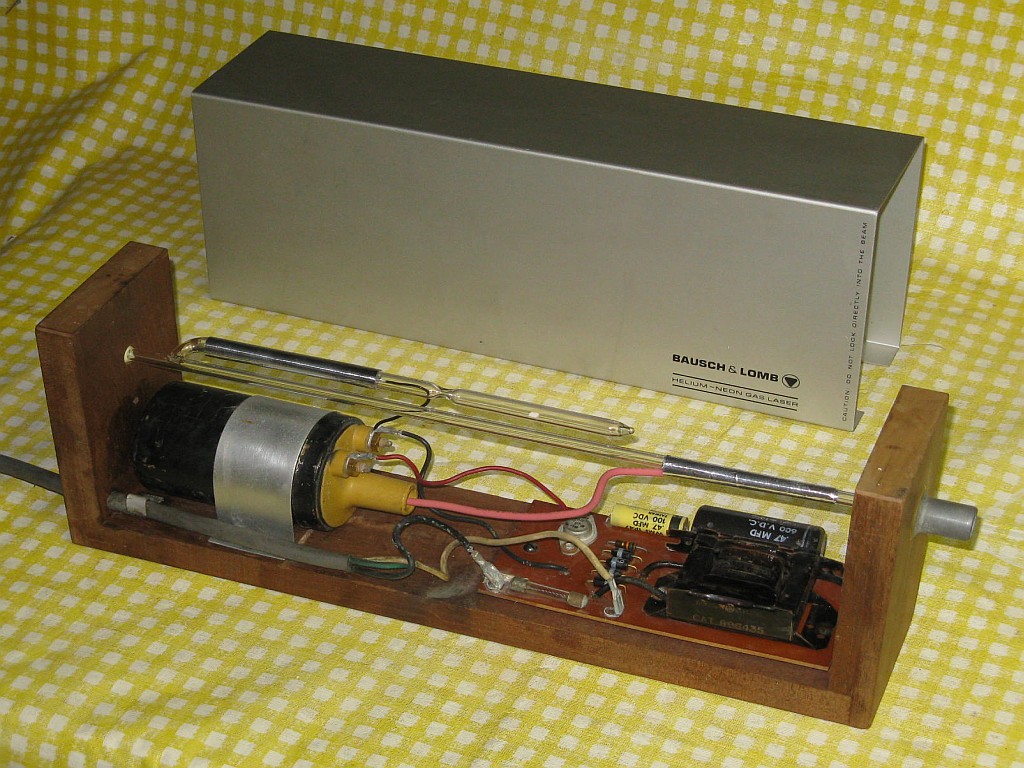
And yes, that skinny thing is the laser tube with not much of a gas reservoir. 🙁 It has internal Epoxy-sealed mirrors and is sort of RF-excited as there are no electrodes in the tube and is held in place with a spring behind the its back-end. There is a rock, well actually a small white pellet of something inside the tube, put there on purpose since it’s in the extension partially pinched off from the main part of the tube to prevent it from migrating and blocking the bore.
(From: Bob Arkin.)
The white rock was a dessicant to remove water vapor from the crappy Epoxy sealed windows. So, it is a sort of very limited getter. (The Optics Technology brand He-Ne lasers had carbon chunks instead.)
The power supply uses an bridge rectifier, SCR, and automotive-style induction coil to ionize the gas 120 times per second using two pieces of copper foil wrapped around the tube near the ends. A fluorescent lamp ballast inductor limits current. So it’s a pulsed He-Ne. 🙂 The connections to the tube are simply pieces of foil. Originally they were copper but my replacements are aluminum. So be it. It is way beyond any hope of lasing but the power supply does work resulting in a blue-white discharge.
The instruction manual (courtesy of Meredith Instruments) may be found at Vintage Lasers and Accessories Brochures and Manuals under “Bausch and Lomb”. The only “instructions” are pretty much to plug it in. (There is no power switch.) If it doesn’t lase, replace the tube. 🙂 However, there is a schematic.
More to come.
ENL-911 Two-Brewster HeNe Laser Head
This one also must be really old as the two-Brewster plasma tube has a hot filament. The markings on the glass are “ENL-911”. See below:
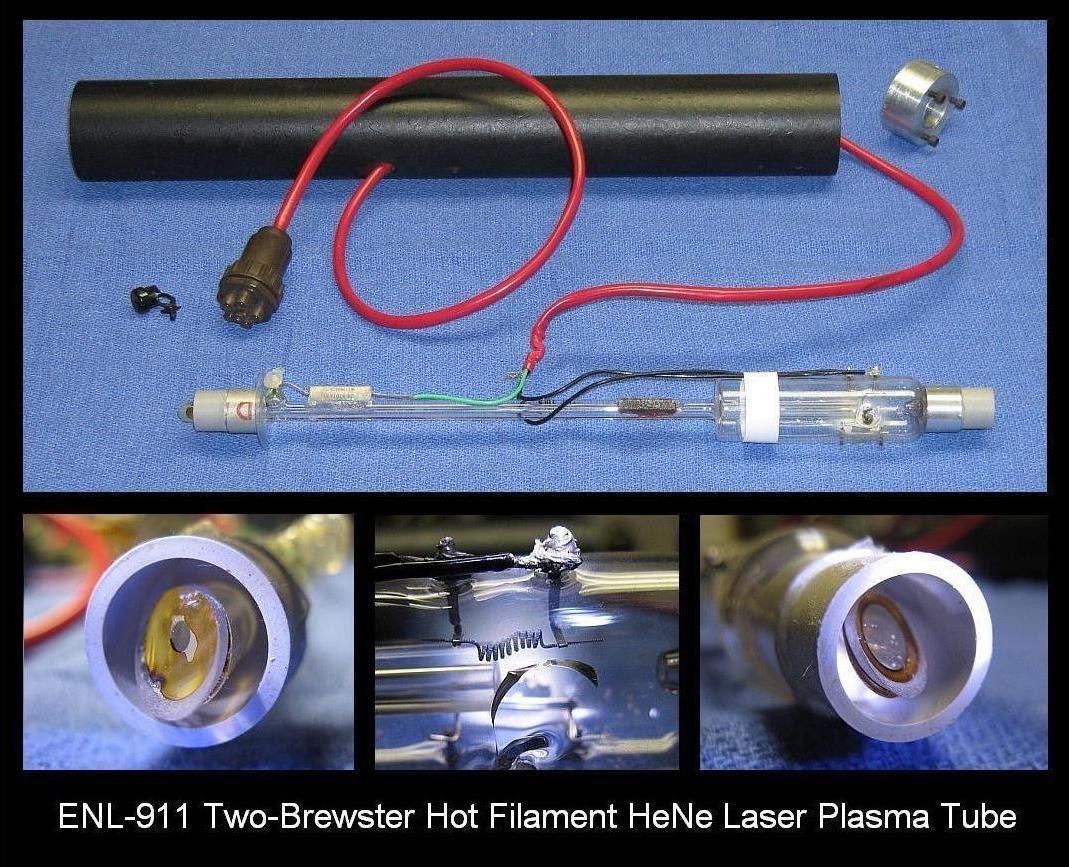
As can be seen, it has a narrow bore like a modern tube and a small gas reservoir at one end. The single ballast resistor is only 15K ohms, so, there must be additional ballast in the mating power supply. There is also a lone magnet near the center glued to the bore, purpose unknown. For IR suppression, there are normally multiple magnets with opposite polarities all along the bore. Its purpose must not be to attract debris being in exactly the worst place for that. 😉 The mirror plates were missing but one of the rings to which they would attached can be seen at the upper left. The laser head has a connector identical to that used on some other more conventional Oriel He-Ne lasers but that may just be a coincidence as there is no other evidence to suggest this is an Oriel laser. There are no markings on the head cylinder.
I later acquired a similar laser head that was more complete so details of the mirror and mounts could be documented.
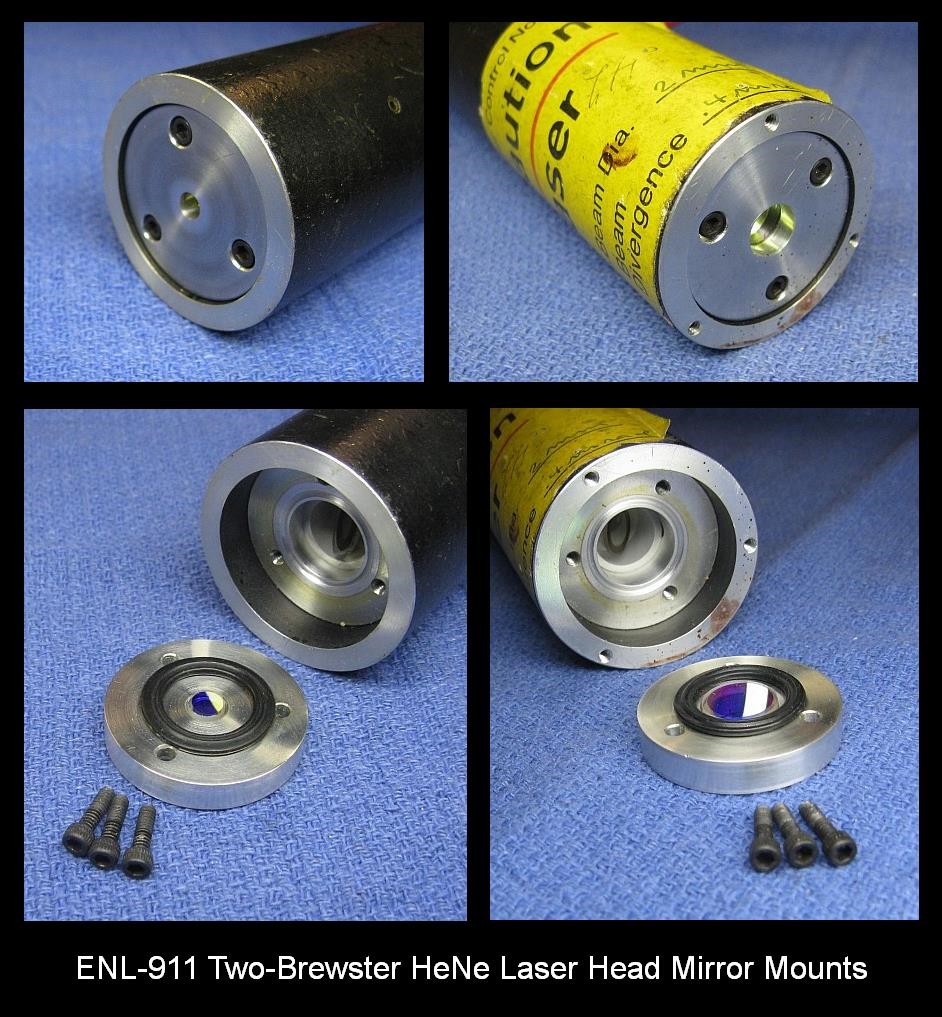
The HR mirror is small and planar while the OC mirror is much larger and curved. Mirror adjustments are via the 3 screws with a rubber ring providing the compliance force. There doesn’t appear to be anything at either end preventing accidental twiddling and total loss of alignment. Although there is no model label on this laser, it is clearly of similar construction with identical wire colours. 🙂 However, it is not identical. For one thing, the cylinder has holes which the ENL911 lacked. And the tube has gas reservoirs at both ends while the ENL911 only has one at the cathode-end. Sorry, no exploded view of this one, some set screws glued or rusted in place so disassembly would be a major effort. 🙂 There was no detectable filament glow when powered at up to 9 V so I’m assuming it is up to air.
(Portions from: Bob Arkin.)
These are from a long defunct company called “Eletro-Nuclear Laboratories, Inc.”. There were two models, this uses a single ended tube. There was also a double ended tube with the hot cathode in the middle. The single magnet was indeed for IR suppression.
The power supply had the cathode lead out as two wires from a center tapped filament transformer with a wirewound adjustable Ohmite to set the filament temperature. So the plug had two pins for the cathode, one for the anode, and two used as a jumper to kill the PS circuit if no head was plugged in. And, yes, there was a limiting resistor in the power supply and just a single resistor thrown onto the tube as a ballast.

